
The most distant human-made object

No spacecraft has gone farther than NASA's Voyager 1. Launched in 1977 to fly by Jupiter and Saturn, Voyager 1 crossed into interstellar space in August 2012 and continues to collect data.
Mission Type

What is Voyager 1?
Voyager 1 has been exploring our solar system since 1977. The probe is now in interstellar space, the region outside the heliopause, or the bubble of energetic particles and magnetic fields from the Sun. Voyager 1 was launched after Voyager 2, but because of a faster route it exited the asteroid belt earlier than its twin, and it overtook Voyager 2 on Dec. 15, 1977.
- Voyager 1 discovered a thin ring around Jupiter and two new Jovian moons: Thebe and Metis.
- At Saturn, Voyager 1 found five new moons and a new ring called the G-ring.
- Voyager 1 was the first spacecraft to cross the heliosphere, the boundary where the influences from outside our solar system are stronger than those from our Sun.
- Voyager 1 is the first human-made object to venture into interstellar space.
In Depth: Voyager 1
Voyager 1 at jupiter.
Voyager 1 began its Jovian imaging mission in April 1978 at a range of 165 million miles (265 million km) from the planet. Images sent back by January the following year indicated that Jupiter’s atmosphere was more turbulent than during the Pioneer flybys in 1973–1974.
Beginning on Jan. 30, 1979, Voyager 1 took a picture every 96 seconds for a span of 100 hours to generate a color time-lapse movie to depict 10 rotations of Jupiter. On Feb. 10, the spacecraft crossed into the Jovian moon system and by early March, it had already discovered a thin (less than 19 miles, or 30 kilometers, thick) ring circling Jupiter.
Voyager 1’s closest encounter with Jupiter was at 12:05 UT on March 5, 1979 at a range of about 174,000 miles (280,000 kilometers). It encountered several of Jupiter’s moons, including Amalthea, Io, Europa, Ganymede, and Callisto, returning spectacular photos of their terrain, opening up completely new worlds for planetary scientists.
The most interesting find was on Io, where images showed a bizarre yellow, orange, and brown world with at least eight active volcanoes spewing material into space, making it one of the most (if not the most) geologically active planetary body in the solar system. The presence of active volcanoes suggested that the sulfur and oxygen in Jovian space may be a result of the volcanic plumes from Io, which are rich in sulfur dioxide. The spacecraft also discovered two new moons, Thebe and Metis.
Voyager 1 at Saturn
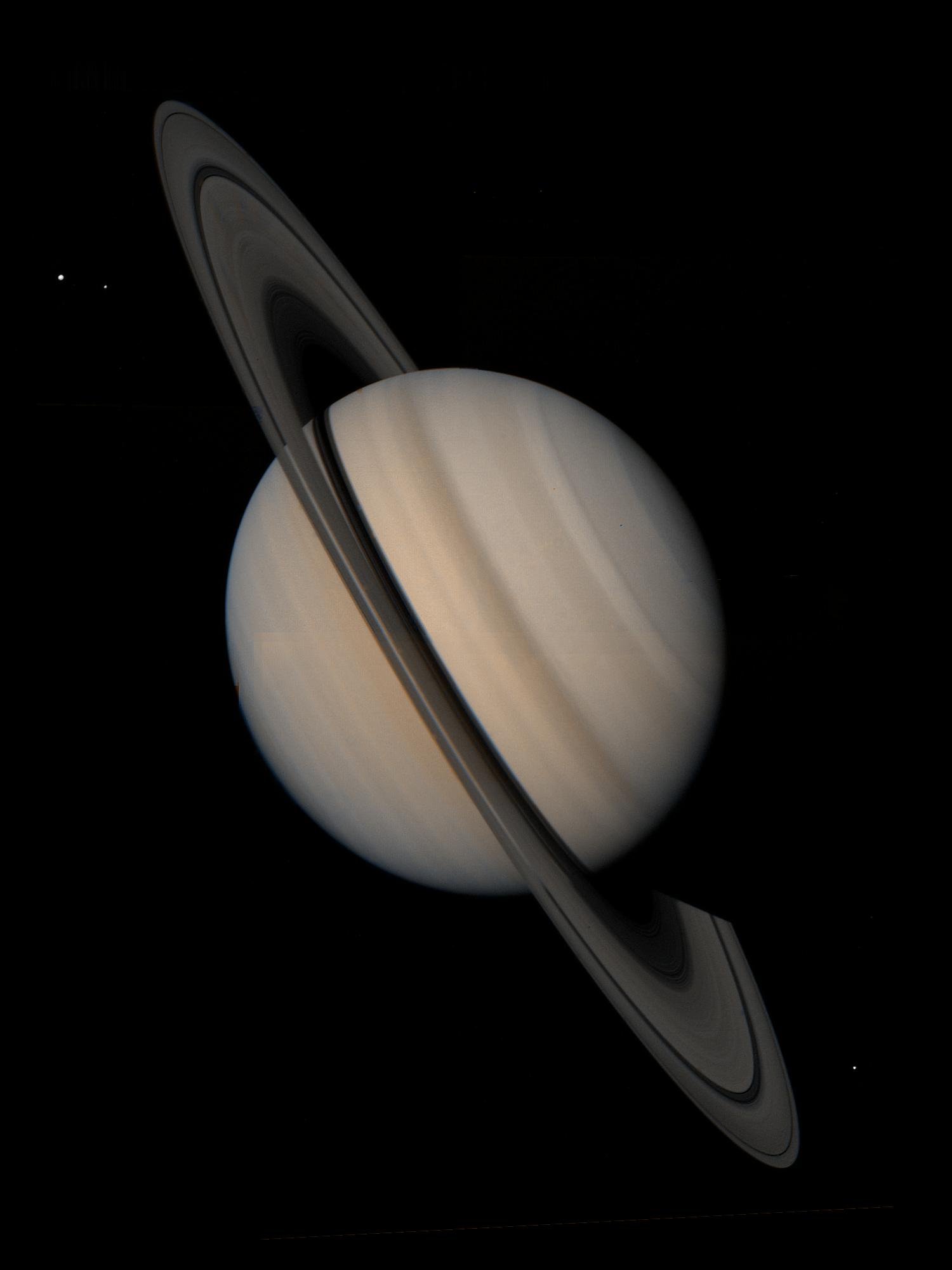
Following the Jupiter encounter, Voyager 1 completed an initial course correction on April 9, 1979, in preparation for its meeting with Saturn. A second correction on Oct. 10, 1979, ensured that the spacecraft would not hit Saturn’s moon Titan.
Its flyby of the Saturn system in November 1979 was as spectacular as its previous encounter. Voyager 1 found five new moons, a ring system consisting of thousands of bands, wedge-shaped transient clouds of tiny particles in the B ring that scientists called “spokes,” a new ring (the “G-ring”), and “shepherding” satellites on either side of the F-ring—satellites that keep the rings well-defined.
During its flyby, the spacecraft photographed Saturn’s moons Titan, Mimas, Enceladus, Tethys, Dione, and Rhea. Based on incoming data, all the moons appeared to be composed largely of water ice. Perhaps the most interesting target was Titan, which Voyager 1 passed at 05:41 UT on Nov. 12 at a range of 2,500 miles (4,000 kilometers). Images showed a thick atmosphere that completely hid the surface. The spacecraft found that the moon’s atmosphere was composed of 90% nitrogen. Pressure and temperature at the surface was 1.6 atmospheres (1 atmosphere equals the average air pressure at sea level on Earth) and minus 290°F (minus 179°C), respectively.
Atmospheric data suggested that Titan might be the first body in the solar system (apart from Earth) where liquid could exist on the surface. In addition, the presence of nitrogen, methane, and more complex hydrocarbons indicated that prebiotic chemical reactions might be possible on Titan.
Voyager 1’s closest approach to Saturn was at 23:46 UT on Nov. 12, 1980, at a range of 78,000 miles (126,000 kilometers).
Voyager 1’s ‘Family Portrait’ Image
Following the encounter with Saturn, Voyager 1 headed on a trajectory escaping the solar system at a speed of about 3.5 AU per year, 35° out of the ecliptic plane to the north, in the general direction of the Sun’s motion relative to nearby stars. Because of the specific requirements for the Titan flyby, the spacecraft was not directed to Uranus and Neptune.
The final images taken by the Voyagers comprised a mosaic of 64 images taken by Voyager 1 on Feb. 14, 1990, at a distance of 40 AU, of the Sun and all the planets of the solar system (although Mercury and Mars did not appear, the former because it was too close to the Sun and the latter because Mars was on the same side of the Sun as Voyager 1 so only its dark side faced the cameras).
This was the so-called “pale blue dot” image made famous by Cornell University professor and Voyager science team member Carl Sagan (1934-1996). These were the last of a total of 67,000 images taken by the two spacecraft.
Voyager 1’s Interstellar Mission
With all the planetary encounters finally over in 1989, the missions of Voyager 1 and 2 were declared part of the Voyager Interstellar Mission (VIM), which officially began on Jan. 1, 1990.
The goal was to extend NASA’s exploration of the solar system beyond the neighborhood of the outer planets to the outer limits of the Sun’s sphere of influence, and “possibly beyond.” Specific goals include collecting data on the transition between the heliosphere, the region of space dominated by the Sun’s magnetic field and solar field, and the interstellar medium.
On Feb. 17, 1998, Voyager 1 became the most distant human-made object in existence when, at a distance of 69.4 AU from the Sun, it “overtook” Pioneer 10.
On Dec. 16, 2004, Voyager scientists announced that Voyager 1 had reported high values for the intensity for the magnetic field at a distance of 94 AU, indicating that it had reached the termination shock and had now entered the heliosheath.
The spacecraft finally exited the heliosphere and began measuring the interstellar environment on Aug. 25, 2012, the first spacecraft to do so.
On Sept. 5, 2017, NASA marked the 40th anniversary of its launch, as it continues to communicate with NASA’s Deep Space Network and send data back from four still-functioning instruments – the cosmic-ray telescope, the low-energy charged particles experiment, the magnetometer, and the plasma waves experiment.
The Golden Record

Each of the Voyagers contain a “message,” prepared by a team headed by Carl Sagan, in the form of a 12-inch (30-centimeter) diameter gold-plated copper disc for potential extraterrestrials who might find the spacecraft. Like the plaques on Pioneers 10 and 11, the record has inscribed symbols to show the location of Earth relative to several pulsars.
The records also contain instructions to play them using a cartridge and a needle, much like a vinyl record player. The audio on the disc includes greetings in 55 languages, 35 sounds from life on Earth (such as whale songs, laughter, etc.), 90 minutes of generally Western music including everything from Mozart and Bach to Chuck Berry and Blind Willie Johnson. It also includes 115 images of life on Earth and recorded greetings from then-U.S. President Jimmy Carter (1924– ) and then-UN Secretary-General Kurt Waldheim (1918–2007).
By January 2024, Voyager 1 was about 136 AU (15 billion miles, or 20 billion kilometers) from Earth, the farthest object created by humans, and moving at a velocity of about 38,000 mph (17.0 kilometers per second) relative to the Sun.

National Space Science Data Center: Voyager 1
A library of technical details and historic perspective.

Beyond Earth: A Chronicle of Deep Space Exploration
A comprehensive history of missions sent to explore beyond Earth.
Discover More Topics From NASA

Our Solar System

What Voyager 1 Learned at Jupiter 40 Years Ago
It was 40 years ago today (March 5) that Voyager 1 flew past Jupiter, revealing a surprising planetary system that includes moons of ice and fire. And scientists are still looking at some of these moons for signs of habitability for microbes.
Voyager 1 and its twin spacecraft, Voyager 2, both left Earth in 1977 on the trail of an unusual planetary alignment that happens every 175 years, according to NASA . The gas giant planets Jupiter, Saturn, Uranus and Neptune lined up in such a way that a spacecraft could use the gravitational field of one planet to swing on to the next. Voyager 2 flew past all four planets, while Voyager 1 instead traveled high above the plane of the solar system after visiting Jupiter and Saturn.
Between them, the two spacecraft garnered basic knowledge about these large planets — measuring their atmospheres, their ring systems, their magnetic fields (including Jupiter's especially strong one) and how their inner cores may function. Jupiter had already been visited by the Pioneer spacecraft , but it still held surprises for Voyager 1 when it flew by in 1979.
Related: Voyager 1's Most Amazing Photos of Jupiter
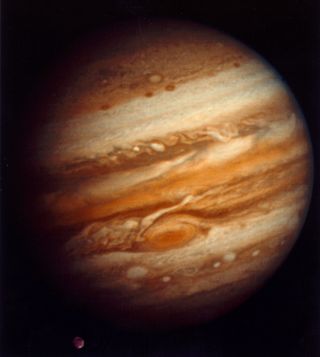
Related: Voyager at 40: 40 Photos from NASA's Epic 'Grand Tour' Mission
"Jupiter's atmosphere was found to be more active than during the visits of Pioneer 10 and 11, sparking a rethinking of the earlier atmospheric models which could not explain the new features. The spacecraft imaged the moons Amalthea, Io, Europa, Ganymede and Callisto, showing details of their terrain for the first time," NASA officials said in a statement .
"Possibly the most stunning of Voyager 1's discoveries was that Io has extremely active volcanoes, powered by heat generated by the stretching and relaxing the moon endures every 42 hours as its elliptical orbit brings it closer to and then farther from Jupiter," NASA officials added. "The spacecraft also discovered a thin ring around the planet (then making it the second planet known to have a ring), and two new moons: Thebe and Metis."
Get the Space.com Newsletter
Breaking space news, the latest updates on rocket launches, skywatching events and more!
Io's volcanic plumes are now being imaged regularly by NASA's Juno spacecraft . And Voyager's discoveries at Europa, Ganymede and Callisto will soon result in a more close-up examination of these bodies. These moons have icy surfaces and probable global oceans underneath, according to joint observations from the Voyager spacecraft, Galileo mission (which orbited Jupiter between 1995 and 2002); and even the Hubble Space Telescope, which spotted periodic spurts of what appears to be water emanating from Europa. Thanks to the intense flexing these moons' interiors receive as they orbit Jupiter, it's possible that the oceans host all the ingredients necessary for life. But scientists need more spacecraft observations to confirm this.
NASA is hard at work on the Europa Clipper , which is expected to go into orbit around Europa in the 2030s to see if this icy moon is host to conditions that could support microbial life. The European Space Agency's JUpiter ICy moons Explorer (JUICE) mission will launch from Earth in 2022 to study all three icy moons, but most especially Ganymede. JUICE will study the moons' oceans, ice layers and general geology, as well as learn more about their exospheres (tenuous atmospheres) and magnetic fields.
- 5 Facts About NASA's Far-Flung Voyager Spacecraft
- Voyager 1 Just Fired Up its Backup Thrusters for the 1st Time in 37 Years
- Massive Storms Swirl on Jupiter in This Awesome NASA Photo
Follow Elizabeth Howell on Twitter @howellspace . Follow us on Twitter @Spacedotcom and on Facebook .
Join our Space Forums to keep talking space on the latest missions, night sky and more! And if you have a news tip, correction or comment, let us know at: [email protected].
Elizabeth Howell (she/her), Ph.D., is a staff writer in the spaceflight channel since 2022 covering diversity, education and gaming as well. She was contributing writer for Space.com for 10 years before joining full-time. Elizabeth's reporting includes multiple exclusives with the White House and Office of the Vice-President of the United States, an exclusive conversation with aspiring space tourist (and NSYNC bassist) Lance Bass, speaking several times with the International Space Station, witnessing five human spaceflight launches on two continents, flying parabolic, working inside a spacesuit, and participating in a simulated Mars mission. Her latest book, " Why Am I Taller ?", is co-written with astronaut Dave Williams. Elizabeth holds a Ph.D. and M.Sc. in Space Studies from the University of North Dakota, a Bachelor of Journalism from Canada's Carleton University and a Bachelor of History from Canada's Athabasca University. Elizabeth is also a post-secondary instructor in communications and science at several institutions since 2015; her experience includes developing and teaching an astronomy course at Canada's Algonquin College (with Indigenous content as well) to more than 1,000 students since 2020. Elizabeth first got interested in space after watching the movie Apollo 13 in 1996, and still wants to be an astronaut someday. Mastodon: https://qoto.org/@howellspace
China lands Chang'e 6 sample-return probe on far side of the moon, a lunar success (video)
Science and music festival Starmus VII is about to rock Bratislava with a stellar lineup
China's Chang'e 6 probe launches samples of far side of the moon to lunar orbit. Next stop? Earth (photos)
Most Popular
- 2 NASA 3D Instagram 'experience' brings nebulas into your home
- 3 Sun unleashes giant plasma plume and reels it back in apparent 'failed eruption' (video)
- 4 Mars is more prone to devastating asteroid impacts than we thought, new study hints
- 5 16 best places to see the 2027 total solar eclipse
First and Farthest: How the Voyagers Blazed Trails

Few missions can match the achievements of NASA's groundbreaking Voyager 1 and 2 spacecraft during their 40 years of exploration.
Few missions can match the achievements of NASA's groundbreaking Voyager 1 and 2 spacecraft during their 40 years of exploration. Here's a short list of their major accomplishments to date.
Planetary Firsts
Launched in 1977, the Voyagers delivered many surprises and discoveries from their encounters with the gas giants of the outer solar system: Jupiter, Saturn, Uranus and Neptune. Between 1977 and 1990, the mission attained these distinctions:
- First spacecraft to fly by all four planets of the outer solar system (Voyager 2)
- First mission to discover multiple moons of the four outer planets (both spacecraft):
- 3 new moons at Jupiter
- 4 new moons at Saturn
- 11 new moons at Uranus
- 6 new moons at Neptune
- First spacecraft to fly by four different target planets (Voyager 2)
- First spacecraft to visit Uranus and Neptune (Voyager 2)
- First spacecraft to image the rings of Jupiter, Uranus and Neptune (Voyager 2)
- First spacecraft to discover active volcanoes beyond Earth (on Jupiter's moon Io -- Voyager 1)
- First spacecraft to detect lightning on a planet other than Earth (at Jupiter -- Voyager 1)
- First spacecraft to find suggestions of an ocean beyond Earth (at Jupiter's moon Europa -- both spacecraft)
- First spacecraft to detect a nitrogen-rich atmosphere found beyond our home planet (at Saturn's moon Titan -- Voyager 1)
Heliophysics Firsts
After Voyager 1 departed from Saturn in November 1980, it began a journey to where no human-made object had ever gone before: the space between the stars. On August 25, 2012, it crossed over into interstellar space, leaving behind the heliosphere -- the enormous magnetic bubble encompassing our Sun, planets and solar wind. Voyager 2 set course for interstellar space after departing from Neptune in August 1989, and is expected to enter interstellar space in the next few years. Together the Voyagers have taught us a great deal about the extent of our sun's influence and the very nature of the space that lies beyond our planets.
- First spacecraft to leave the heliosphere and enter interstellar space (Voyager 1)
- First spacecraft to measure full intensity of cosmic rays -- atoms accelerated to nearly the speed of light -- in interstellar space (Voyager 1)
- First spacecraft to measure magnetic field in interstellar space (Voyager 1)
- First spacecraft to measure density of interstellar medium -- material ejected by ancient supernovae (Voyager 1)
- First spacecraft to measure solar wind termination shock -- the boundary where solar wind charged particles slow below the speed of sound as they begin to press into the interstellar medium (Voyager 2)
Engineering and Computing Firsts and Records
The Voyagers, which launched with nearly identical configurations and instruments, were designed to withstand the harsh radiation environment of Jupiter -- the greatest physical challenge they would ever encounter. Preparations for the peril at Jupiter ensured that the Voyagers would be well equipped for the rest of their journeys, too. Engineering and computing advances that the Voyagers debuted set the stage for future missions.
- First spacecraft extensively protected against radiation, which also set the standard for radiation design margin still in use for space missions today
- First spacecraft protected against external electrostatic discharges
- First spacecraft with programmable computer-controlled attitude and articulation (which means the pointing of the spacecraft)
- First spacecraft with autonomous fault protection, able to detect its own problems and take corrective action
- First use of Reed-Solomon code for spacecraft data -- an algorithm to reduce errors in data transmission and storage, which is widely used today
- First time engineers linked ground communications antennas together in an array to be able to receive more data (for Voyager 2's Uranus encounter)
Beyond that, the Voyager spacecraft continue setting endurance and distance records:
- Longest continuously operating spacecraft (Voyager 2, which passed Pioneer 6's record on Aug. 13, 2012)
- Most distant spacecraft from the Sun (Voyager 1, which passed Pioneer 10's distance on Feb. 17, 1998 and is currently about 13 billion miles, or 21 billion kilometers, away)
The Voyager spacecraft were built by NASA's Jet Propulsion Laboratory, Pasadena, California, which continues to operate both. JPL is a division of Caltech in Pasadena. The Voyager missions are a part of the NASA Heliophysics System Observatory, sponsored by the Heliophysics Division of the Science Mission Directorate in Washington. For more information about the Voyager spacecraft, visit:
https://www.nasa.gov/voyager
https://voyager.jpl.nasa.gov
News Media Contact
Elizabeth Landau
Headquarters, Washington
202-358-0845
We have completed maintenance on Astronomy.com and action may be required on your account. Learn More

- Login/Register
- Solar System
- Exotic Objects
- Upcoming Events
- Deep-Sky Objects
- Observing Basics
- Telescopes and Equipment
- Astrophotography
- Space Exploration
- Human Spaceflight
- Robotic Spaceflight
- The Magazine
How Voyager opened the door to the ice giants

Voyager 2 flew past Uranus on January 24, 1986, more than four years after the probe visited Saturn. Following the excitement at that ringed world (and Jupiter before it), scientists were eager to see what Voyager would reveal at the more distant and enigmatic uranian system.
Suzy Dodd, the project manager for Voyager’s interstellar mission, worked on the sequencing teams for Uranus and Neptune. The group determined exactly when Voyager’s instruments should take data in order to return the information the science team wanted. This meant understanding in minute detail how the planets and their moons moved. The sequencing team orchestrated the various instruments to use every second of the precious flyby windows to image the most valuable targets: the limb or edge of the planets, the terminators where day and night meet, the moons in their orbits, and the planets’ own broad faces.
After the rich and complex atmospheres of Jupiter and Saturn, Uranus seemed pretty bland, Dodd recalls. “You didn’t get all the great storms you got at the other planets,” she says. Instead, Uranus “looked like a fuzzy, blue tennis ball.”
Voyager did reveal a previously undetected magnetic field around Uranus, comparable in strength to Earth’s. Due to its nearly 90° axial tilt, Uranus rolls around its orbit like a ball. And while Earth’s orbital and magnetic fields are offset by roughly 12°, Uranus’ are 60° apart. This results in a corkscrewing magnetic field trailing millions of miles behind the planet.
What’s more, scientists still aren’t sure why the magnetic field exists at all, since Uranus lacks the standard liquid metallic inner layer that powers such fields on other planets. Voyager also revealed intense radiation belts around the planet, similar to those seen at Saturn.

Astronomers at Cornell University discovered Uranus’ ring system in early 1977, just before Voyager’s launch. The sighting was a happy accident, when a chance alignment carried Uranus in front of a distant star. Scientists had planned to use the occultation to study Uranus’ atmosphere, but the star’s repeated appearance and disappearance before it slid out of view behind the planet made astronomers realize that a series of rings surrounded our far-off neighbor. The flyby was a chance to investigate them up close.
Voyager imaged the ring system for the first time, informing astronomers of its detailed structure. The spacecraft also discovered two entirely new rings. The close-up views confirmed that Uranus’ subtle bands are not like Saturn’s bright icy rings; they are dark and reflect little light, making them difficult to see. Scientists think the rings are probably made mostly of ice, like Saturn’s, but covered in organic material such as methane, and then baked dark by the planet’s radiation belts.
Uranus’ moons, too, camouflage well against the dark of space. When Voyager left Earth, astronomers knew of only five satellites around the planet. From observations during its brief visit, the spacecraft tripled that number, yielding 10 new moons. “I really think the satellites were the highlight of Uranus,” says Dodd. Voyager images lent the five larger known moons detail and character, telling varied stories of violent pasts.
Two of the new moons, Cordelia and Ophelia, were identified as shepherd moons. They orbit on either side of Uranus’ outer Epsilon ring, and their gravitational pull herds the small particles in that ring along their orbital path and keeps them from dissipating into space. Uranus’ rings are uncommonly narrow; without shepherd moons, the small particles would disperse over long timescales.
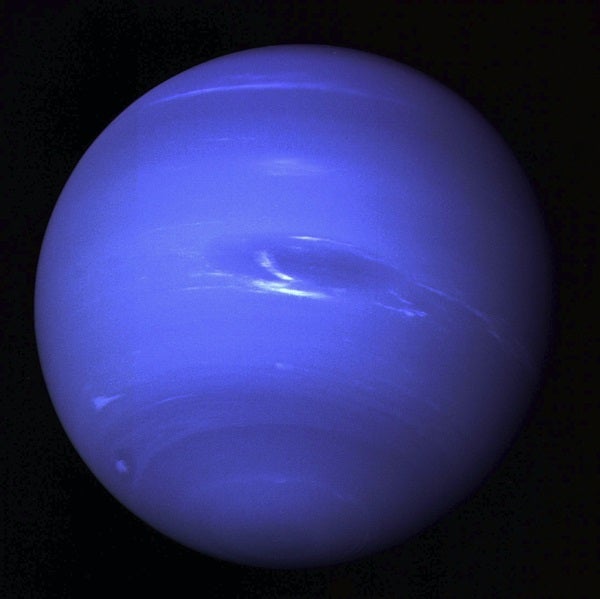
Last year, astronomers from the University of Idaho revisited the Voyager data. Thirty years after the flyby, they found evidence for two more tiny moonlets shaping Uranus’ rings. “Nobody — or not many people — had looked at this in a very long time,” says Robert Chancia, who led the investigation. In fact, the Voyager data were taken before he was born. Chancia and his adviser, Matthew Hedman, usually study Saturn’s rings. But recent discoveries by the Cassini spacecraft have added greatly to astronomers’ understanding of planetary rings. So Chancia and Hedman decided to take another look at the Voyager findings, applying new theories to old data.
“There are several narrow ringlets within the rings of Saturn” that provide reasonable proxies for Uranus’ system, Chancia explains. So he and Hedman adopted techniques that planetary scientist Mark Showalter used to find the moonlet Pan in Voyager 2’s observations of Saturn’s ring system.
They found distinct patterns in Uranus’ rings consistent with “wakes” carved by moonlets circling a planet within a ring system. The predicted moonlets are tiny, only 2 to 9 miles (4 to 14 kilometers) across. And they are likely dark, like the rest of the moons and ring system. Confirming the moonlets will be a challenge. But even 30 years later, Voyager is still helping to crack Uranus’ secrets.
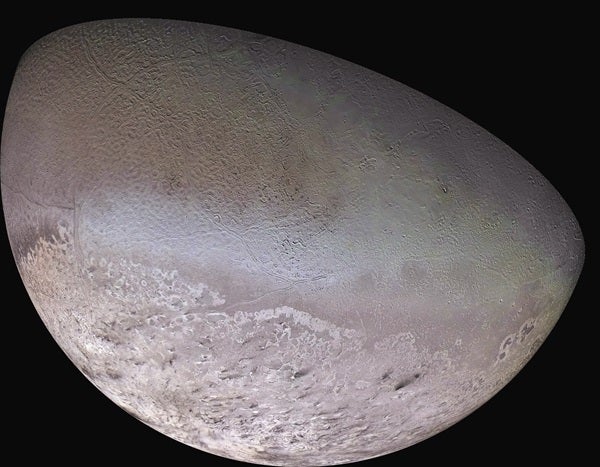
Voyager’s last planetary encounter came August 24, 1989. Far from Uranus’ “fuzzy tennis ball,” Neptune was alive with storms and bright, quick-moving clouds, delighting unsuspecting astronomers. Clouds not only appeared clearly in Voyager images, but they also cast shadows on deeper cloud layers, allowing scientists to measure the planet’s atmosphere in great detail. The “Great Dark Spot,” as astronomers termed the largest tempest, was as big as Earth, swirling in Neptune’s southern hemisphere and boasting wind speeds as high as 750 mph (1,200 km/h). In the decades since, that storm has died, while new storms have risen in its place.
“That was a bit of a surprise to me when you consider the Great Red Spot on Jupiter has been going on for 400 years,” Dodd says.
More surprises waited on Triton, Neptune’s biggest moon. Triton was already a hotbed of intrigue; it’s by far the solar system’s largest retrograde satellite, meaning it orbits in the direction opposite to its planet’s rotation. This is usually a sign of a captured object, but most other retrograde moons are small, misshapen asteroids. Triton is three-quarters the size of our Moon, and survived its capture intact. Scientists wanted close-up views of the satellite, and since it was the last target, they were free to adjust Voyager’s trajectory as needed. So the spacecraft swooped only 3,075 miles (4,950km) above Neptune’s north pole — its closest approach to any object during the mission — and flew toward its encounter with Triton.
The last world Voyager 2 visited stunned scientists. The moon boasted a thin atmosphere, polar caps, and active geysers that spewed icy material miles high. The active cryovolcanism puts Triton in a select group of satellites, in the company of other dynamic moons such as Europa and Enceladus.
Voyager also discovered six new moons orbiting Neptune and delivered clear pictures of its ring system for the first time, revealing the rings to be clumpy but complete, unlike those at Uranus.
And as it did at Uranus, Voyager discovered that Neptune’s magnetic pole is misaligned from its rotational pole, causing extreme variations in its magnetic field as the planet rotates. Furthermore, both planets’ magnetospheres are offset from center by a large fraction: about one-third the planet’s radius for Uranus, and nearly half a radius for Neptune. Both planets could have oceans of conductive icy slush that perform the work of the liquid metallic cores at Earth and Jupiter, but inconclusive models and observations have left scientists with little more than guesswork as to what exactly drives the magnetic fields that Voyager observed.
Voyager also detected aurorae on Neptune. Due to the strange and complex nature of the planet’s magnetic field, these aurorae don’t occur only at the poles; instead they are scattered across Neptune’s upper atmosphere.
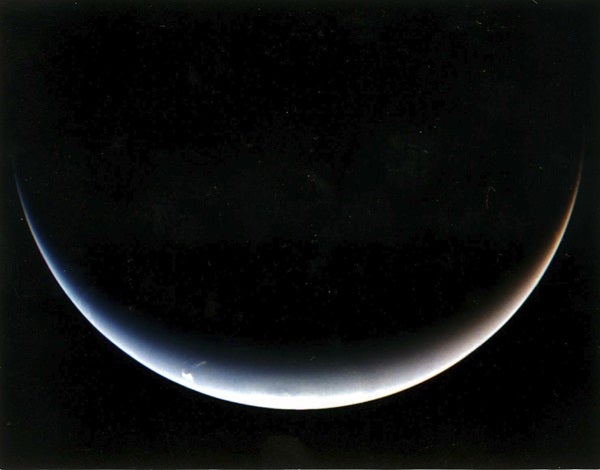
Voyager also closed a contentious chapter in astronomy history by revising Neptune’s mass downward by around half a percent — or roughly the mass of Mars. This miscalculation had sent astronomers on a wild goose chase through the years as they tried to make sense of Uranus’ and Neptune’s orbits, usually by invoking the existence of a mysterious Planet X tugging on both of them. (Pluto was found as a direct result of this hunt, but its small size was never enough to resolve the initial problem.) Voyager settled the issue, as Neptune’s smaller mass means it and Uranus orbit just as they should.
To mark the final flyby, NASA’s Jet Propulsion Laboratory hosted a special event celebrating Voyager’s journey and accomplishments. Scientists shared images with the public, and rock-’n’-roll legend Chuck Berry, whose music lives on as part of Voyager’s Golden Record, played in a special concert.
At the edge of our planetary system, 2.75 billion miles (4.43 billion km) from Earth, Voyager turned its cameras back for a last look, imaging farewell shots of a crescent Neptune. Dodd recalls her reaction to the images: “Wow. The planetary mission is done. We’re going off into the deep dark and cold realms of space. Who knows how long the mission will last?”
When she left her position with the Neptune team, Dodd says, no one then imagined Voyager would continue as long as it has. She returned to Voyager’s interstellar mission in 2010, 21 years after she left the project. In many ways, she admits that the spacecraft is an artifact — memory and power limited, with many of its specialists long since retired or passed on. Since Voyager’s departure from Neptune, many of its instruments have gone quiet. There is no need for imaging cameras in the dark void of space. But that does not mean the project is defunct.
Voyager continues to measure magnetic fields, charged particles, plasma density, and more as it cruises the solar system’s hinterlands, teaching scientists about the subtle edges of the solar system’s boundaries. Voyager 1 has passed beyond the reach of the solar wind, and thus is sampling aspects of interstellar space, though it still lies well within the Sun’s gravitational influence. Voyager 2, following a slower trajectory from its two-planet detour, tags behind, still sampling the solar wind. From their distance, it takes more than 15 hours for their signals to reach Earth.
Sometime in the next decade, the spacecraft will lose power and begin to shut down. Dodd’s team will turn the Voyagers’ heaters off first, and one by one, the science instruments will succumb to the cold of space. But the spacecraft themselves and their Golden Records will journey on, carrying humanity’s imprint into the cosmos.
It will be years before any spacecraft retreads Voyager’s path to Uranus or Neptune. With at least half a century of technological advances behind it, any future craft will undoubtedly revolutionize our understanding of the ice giants all over again. But it’s safe to say that nothing will match Voyager for sheer adventure and scope. Decades after its primary mission, Voyager continues to teach, to inspire, and to explore.

The most common planets in the universe might be rich in carbon
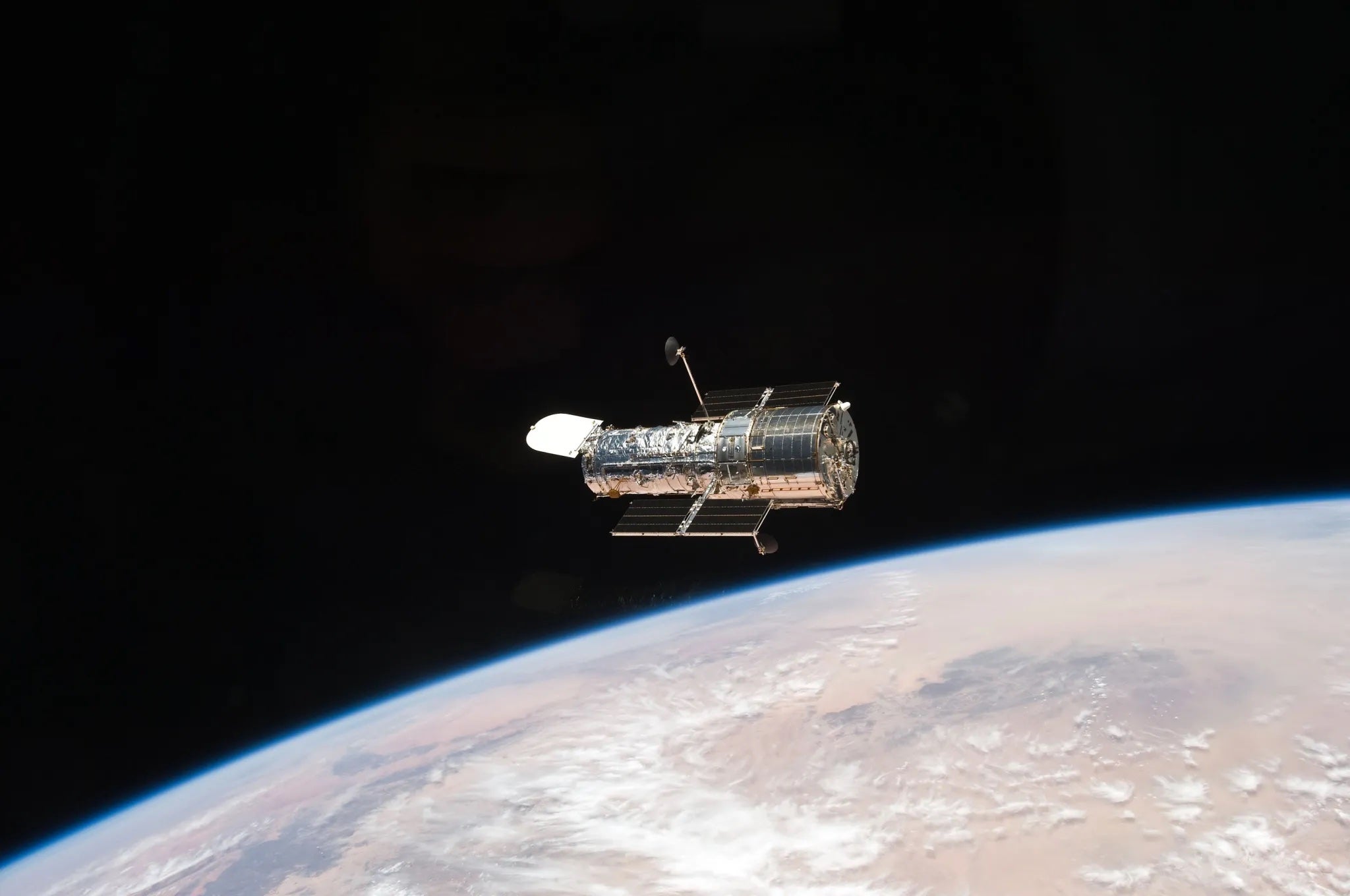
The aging Hubble Space Telescope is not finished quite yet

Hubble finds signature of water vapor in exoplanet GJ 9827d’s atmosphere
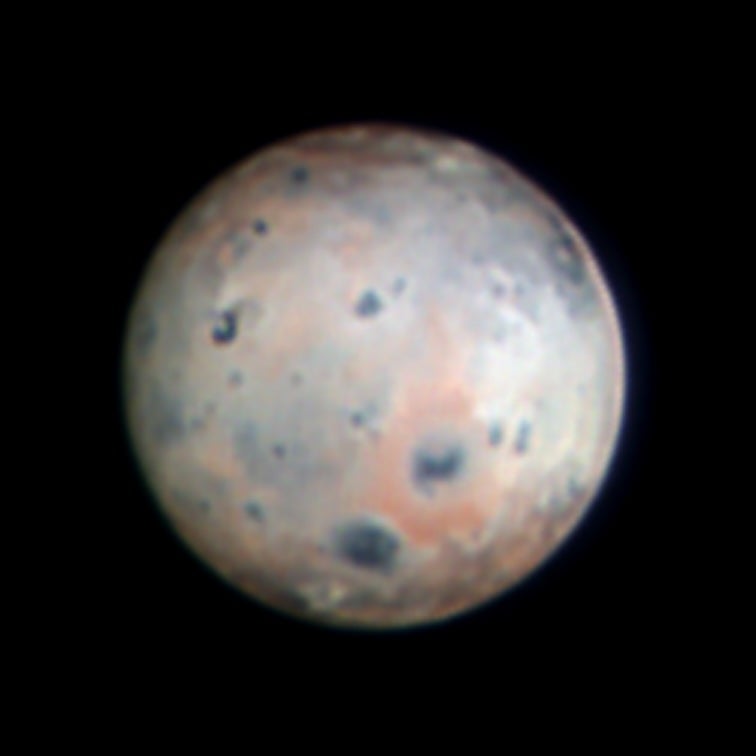
Volcanic moon Io gets close-up look from Earth observatory
Venus likely has active volcanoes, flowing streams of lava.
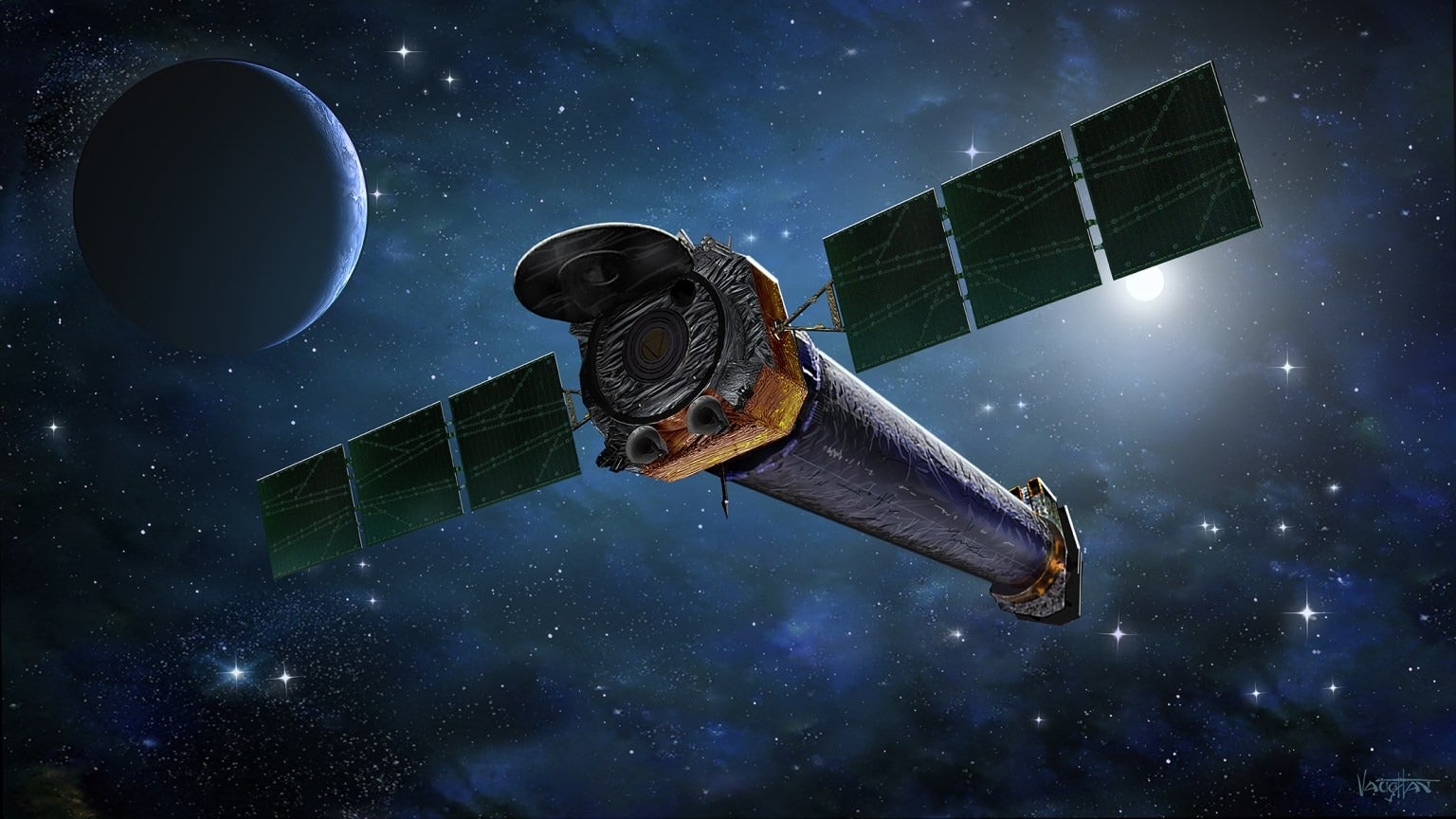
How Chandra’s clear, sharp photos help study supermassive black holes

Is Pluto a planet? It depends.
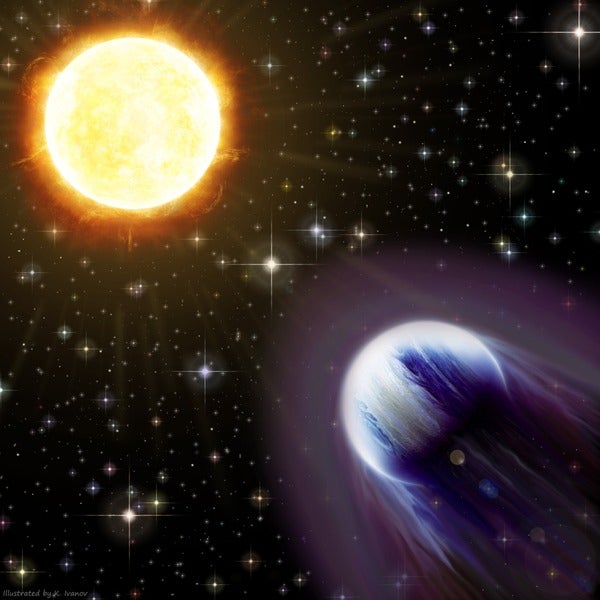
‘This planet should not be there.’ Second lightest exoplanet known to date surprises astronomers
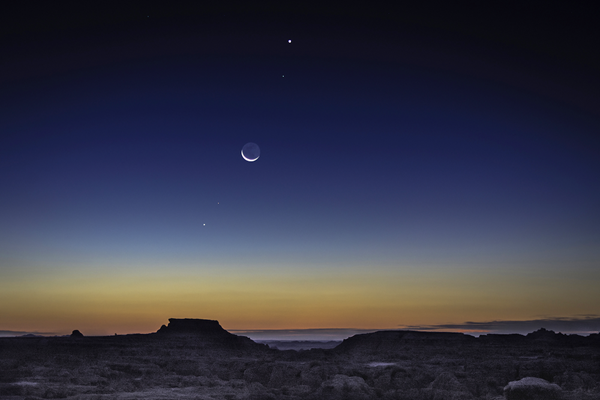
What it means for planets to align
Voyager's Most Amazing Discoveries Were Not Planets, But Moons
The Voyager probes launched to study the planets, but they discovered the wonder of the solar system's moons.

Jupiter's turbulent atmosphere, Saturn's morphing rings, the tilted axis of Uranus, and Neptune's Great Dark Spot—40 years ago, humanity had a vague understanding at best of the solar system's far-out worlds. And then came the Voyager probes' tour of the solar system.
Voyager 2 actually launched first, on August 20, 1977. Voyager 1, the faster craft, left Earth 40 years ago today—September 5, 1977. With thousands of photographs, Voyagers 1 and 2 revealed the outer solar system in all its splendor for the very first time. But for as much as they told us about the gas giants planets, the legendary probes may have made their most shocking revelations by showing us that our own moon is one of the least interesting natural satellites around.
A World of Fire and Brimstone
Linda Morabito found herself on the front lines of discovery by accident. She had landed at NASA's Jet Propulsion Laboratory (JPL) before she finished her undergraduate degree to study the orbits of Jupiter's moons. That work created the navigation strategy for the Voyager mission, and as the probes approached Jupiter, Morabito was working as a navigator for the spacecraft.
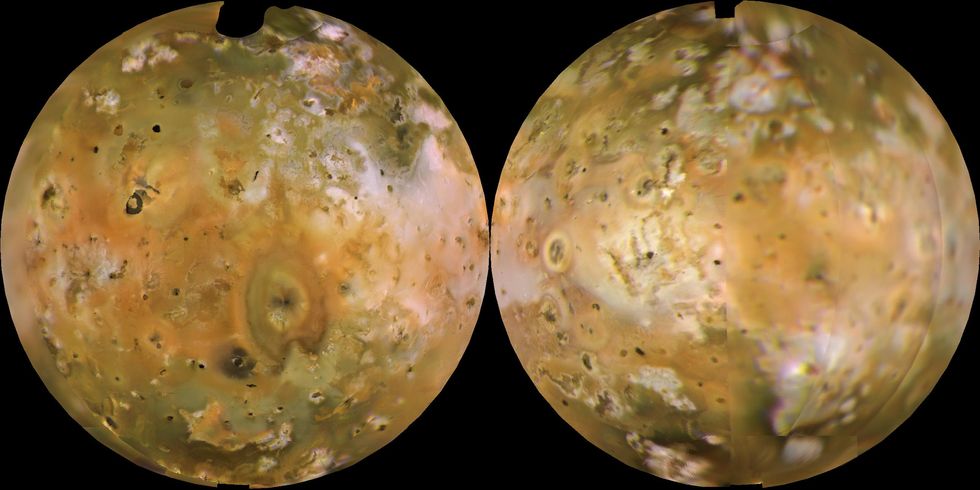
When Galileo discovered Io, Europa, Ganymede, and Callisto, they were nothing more than little dots in the sky, but they provided evidence to challenge humanity's perception of the universe and our place in it. But when the Voyager mission got there, Morabito says, the information was "falling down on us like rain," says Morabito. She barely got any sleep during the Jupiter flybys. The first pictures she saw weren't great—in many cases, they were overexposed—but they were the closest look we ever had of these tantalizing worlds.
On the morning of March 4, 1979, as she was getting ready to go to the lab, Morabito glanced at the television just to see what the scientists were presenting. "I don't think I could have ever anticipated what they were showing. When I saw Io, that wasn't the Io I had been seeing as an overexposed satellite. They talked about this enormous heart-shaped feature on the surface of Io, and I cried! I barely had time to do that, because I was leaving to get to work."
Things got even stranger. When Morabito began examining Voyager 2's images of Io, she could see odd features around the limbs of the moon, but she couldn't quite tell what they were. Then, on March 9, she was looking over post-encounter pictures—images taken while Voyager was looking back over its shoulder as it sped on from Io. Morabito was exhausted, sleep-deprived, and weary from staring at image after image of the same rock floating out in deep space. But no matter how heavy her eyelids grew, Morabito knew immediately when she was the first person in human history to lay eyes on the lava fountains of Io.

There was something faint in her pictures of Jupiter's innermost moon—another moon lurking behind Io, she thought at first. But then she remembered the image she had seen on the television five days earlier, the heart-shaped feature, and suddenly it clicked. She was looking at a plume, a volcanic eruption, some 350 million miles from Earth.
It was a seismic shock to the scientific community. Almost 500 million miles away from the warmth of the sun, in the frigid vacuum of space, Io should be a dull, frozen ball of rock and ice. But it turns out that Jupiter's massive gravitational pull tugs and grinds the rock of Io, creating vast lakes and channels of liquid hot magma, and volcanoes that erupt from the surface of the moon out into space. Some lava fountains on Io reach heights of 250 miles or more. Only about a fourth the size of Earth, Io turned out to be the most volcanically active body in the solar system by a significant margin.
The Hydrocarbon World of Wonders
Carolyn Porco joined Voyager in 1983 after working on a dissertation on Saturn. The knowledge gap comparing the days before and after Voyager's Saturn flyby still astonishes her. "We didn't even know there was structure in the rings!"

Voyager 1 did a lot of work on Saturn and especially Titan, using a remote sensing technique called radio science occultation that measures a moon's physical characteristics. "The spacecraft went behind Titan as seen from the Earth, and its telemetry signal was occulted through the atmosphere," she says. "You could determine a lot: The density profile, the composition, the pressure and temperature of the surface."
The radio signals beamed through Titan's atmosphere by Voyager, received here on Earth, revealed more about the mysterious hydrocarbon world than anyone would have believed. Porco remembers the frenzy that swept through JPL when the first results of Voyager's Titan flyby came down.
"After the occultations I took, the first interpretation of the data by the radio science team was that the conditions of Titan's surface admitted the possibility of liquid nitrogen. Well, this bit just spread like wildfire throughout Building 264, which was where all the scientific teams were gathered for the two-week periods of these flybys. It was like, holy shit . I remember during this episode, all of Building 264 was like the Starship Enterprise and we were the crew."
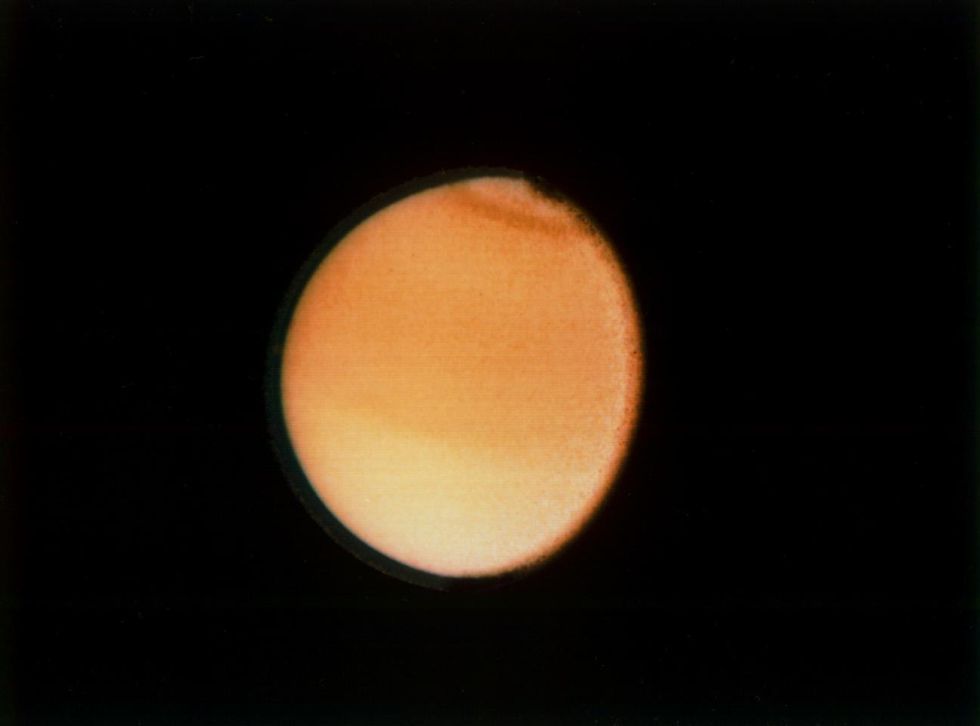
A few days later, the science team changed their interpretation—Titan wasn't cold enough for liquid nitrogen, but it might have liquid methane. They would be proven right... eventually. You see, Voyager could not peer through Titan's thick atmosphere, and so the spacecraft was limited to studying the orange haze of Titan and guessing what lurked beneath. But two decades later, the Cassini spacecraft would deploy the Huygens probe to land on Titan's surface, and Cassini conducted extensive radar mapping of Titan as well.
This 21st century mission, long after Voyager had departed, confirmed what many in Building 264 suspected decades ago. Lakes and rivers of hydrocarbons, mostly methane and ethane, do in fact flow on Titan—a world larger than the planet Mercury. Whether life could lurk in these frigid, alien conditions, is a question that tantalizes planetary scientists to this day.
Liquid Water, 900 Million Miles From the Sun
As intriguing as the orange, hazy moon Titan may be, the moon that stuck with Porco is one of Saturn's smaller satellites, Enceladus. Before Voyager, scientists knew that Enceladus was in Saturn's second outermost ring, the E ring, and it wasn't very big. They didn't know much else about the little world.
Voyager discovered the moon's exact size, which is 310 miles across with a 157-mile mean radius, making Enceladus small enough to fit in the Gulf of Mexico. But it did so much more—Voyager's reading began a line of incredible discoveries about this moon that continues today. When Voyager visited the bright little world, it revealed that any ancient craters on Enceladus had been erased. This was quite unexpected, because when "a moon is inactive or dead, it's surface isn't moving, it is covered with craters," Porco explains. "Moons like Callisto of Jupiter are covered with craters. But there are moons that have tectonic features—the surface is cracked in some way if there's sufficient tectonic activity or you get something molten squirted up through a fracture to remove craters." Enceladus, despite everyone's expectations, was completely smoothed over.

The craters, apparently, had been erased by cryovolcanism. "What was imagined was slushy ice, warm enough to squeeze through fragments and flow extensively," says Porco. This slushy water ice, of course, is rare in space. Voyager found the first indications that Enceladus, like Jupiter's moon Europa, could possibly have liquid water below the surface. (It was not until the Cassini mission, decades later, that scientists learned Enceladus has an entire subsurface ocean that envelops the little world.)
Nobody expected Enceladus to be the star of the show, but the discovery of an active world has kept Porco pushing on the door of Enceladus for decades. As a participant in both Voyager and Cassini, Porco has used her clout to become one of the leading advocates for further study of the small moon of Saturn. The images that Voyager beamed back of a pristine icy world, augmented by Cassini observations of blue tiger stripes crossing the smooth white crust, have led Porco to push for more complete exploration of the world.
During the Cassini mission, Porco first called Enceladus, "the Europa for the Saturn system." Europa , which is also believed to have a global subterranean ocean, is generally considered the planetary body in the solar system most likely to harbor alien life. Now, Porco wants to lead a mission back to Enceladus to study the cryovolcanism and active geology to see if it too could be habitable.
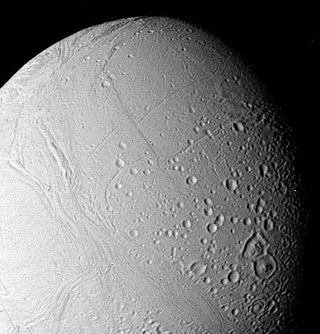
The Voyager missions showed us that extraterrestrial life is not only likely in the vastness of the galaxy, but it could even be right here in our neighborhood, clinging to a moon in the outer solar system. The volcanoes of Io, the methane rivers of Titan, and the waters of Enceladus and Europa all point to the same underlying fact: Even worlds far away from the heat of the sun can be active, warm, covered in liquid, and possibly conducive to life.
But if we're desperate to find life, Linda Morabito says, we need only look up toward the Voyager probes. Scientists who work on the mission are often fond of bringing up each craft's long lifespan and pointing out that, hypothetically, the two spacecraft outlast all life on Earth, carrying a message from humanity on their golden records. Without a doubt, there's life in space, Morabito says. Thanks to Voyager, "we're already there."
To learn more about the Voyager mission, check out PBS's documentary about the spacecraft, The Farthest. The documentary will rebroadcast on PBS on 9/13 at 10/9c, or you stream it for free here .
David Grossman is a staff writer for PopularMechanics.com. He's previously written for The Verge, Rolling Stone, The New Republic and several other publications. He's based out of Brooklyn.

.css-cuqpxl:before{padding-right:0.3125rem;content:'//';display:inline;} Solar System .css-xtujxj:before{padding-left:0.3125rem;content:'//';display:inline;}

The Sun’s Expansion Will Devour Many of Its Childr

We Thought We Knew What Uranus Was Made Of

What It‘s Like To See A Total Solar Eclipse
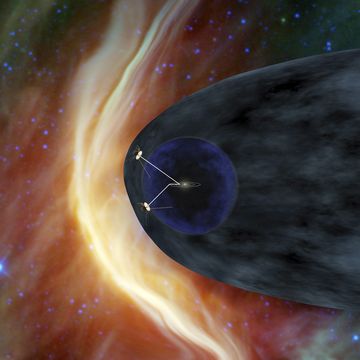
This Is the Best Way to Exit Our Solar System

Stream the Great American Solar Eclipse
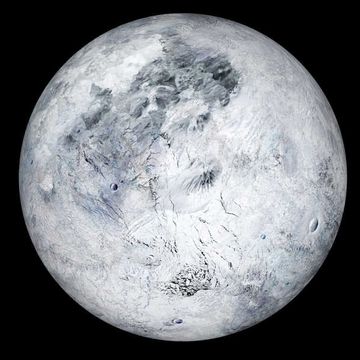
2 Dwarf Planets Are Hiding Something Incredible
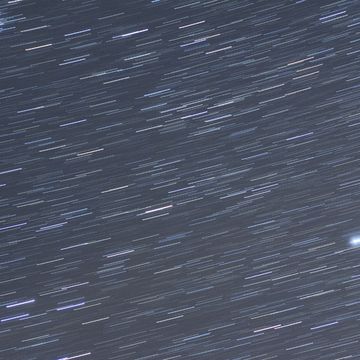
Stars Passed in the Night—and Changed Our Climate
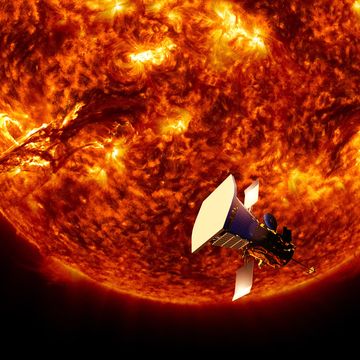
NASA Might As Well Be Walking on the Sun
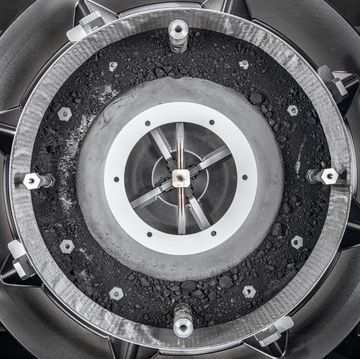
NASA Finally Opened a Canister of Asteroid Dust

The 7 Greatest Cosmic Threats to Life on Earth
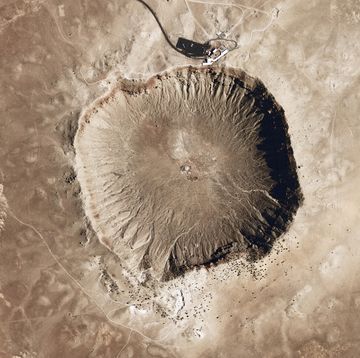
Crater Proves the Universe Has a Wicked Curveball
- Share full article
Advertisement
Supported by
Voyager 1, First Craft in Interstellar Space, May Have Gone Dark
The 46-year-old probe, which flew by Jupiter and Saturn in its youth and inspired earthlings with images of the planet as a “Pale Blue Dot,” hasn’t sent usable data from interstellar space in months.

By Orlando Mayorquin
When Voyager 1 launched in 1977, scientists hoped it could do what it was built to do and take up-close images of Jupiter and Saturn. It did that — and much more.
Voyager 1 discovered active volcanoes, moons and planetary rings, proving along the way that Earth and all of humanity could be squished into a single pixel in a photograph, a “ pale blue dot, ” as the astronomer Carl Sagan called it. It stretched a four-year mission into the present day, embarking on the deepest journey ever into space.
Now, it may have bid its final farewell to that faraway dot.
Voyager 1 , the farthest man-made object in space, hasn’t sent coherent data to Earth since November. NASA has been trying to diagnose what the Voyager mission’s project manager, Suzanne Dodd, called the “most serious issue” the robotic probe has faced since she took the job in 2010.
The spacecraft encountered a glitch in one of its computers that has eliminated its ability to send engineering and science data back to Earth.
The loss of Voyager 1 would cap decades of scientific breakthroughs and signal the beginning of the end for a mission that has given shape to humanity’s most distant ambition and inspired generations to look to the skies.
“Scientifically, it’s a big loss,” Ms. Dodd said. “I think — emotionally — it’s maybe even a bigger loss.”
Voyager 1 is one half of the Voyager mission. It has a twin spacecraft, Voyager 2.
Launched in 1977, they were primarily built for a four-year trip to Jupiter and Saturn , expanding on earlier flybys by the Pioneer 10 and 11 probes.
The Voyager mission capitalized on a rare alignment of the outer planets — once every 175 years — allowing the probes to visit all four.
Using the gravity of each planet, the Voyager spacecraft could swing onto the next, according to NASA .
The mission to Jupiter and Saturn was a success.
The 1980s flybys yielded several new discoveries, including new insights about the so-called great red spot on Jupiter, the rings around Saturn and the many moons of each planet.
Voyager 2 also explored Uranus and Neptune , becoming in 1989 the only spacecraft to explore all four outer planets.

Voyager 1, meanwhile, had set a course for deep space, using its camera to photograph the planets it was leaving behind along the way. Voyager 2 would later begin its own trek into deep space.
“Anybody who is interested in space is interested in the things Voyager discovered about the outer planets and their moons,” said Kate Howells, the public education specialist at the Planetary Society, an organization co-founded by Dr. Sagan to promote space exploration.
“But I think the pale blue dot was one of those things that was sort of more poetic and touching,” she added.
On Valentine’s Day 1990, Voyager 1, darting 3.7 billion miles away from the sun toward the outer reaches of the solar system, turned around and snapped a photo of Earth that Dr. Sagan and others understood to be a humbling self-portrait of humanity.
“It’s known the world over, and it does connect humanity to the stars,” Ms. Dodd said of the mission.
She added: “I’ve had many, many many people come up to me and say: ‘Wow, I love Voyager. It’s what got me excited about space. It’s what got me thinking about our place here on Earth and what that means.’”
Ms. Howells, 35, counts herself among those people.
About 10 years ago, to celebrate the beginning of her space career, Ms. Howells spent her first paycheck from the Planetary Society to get a Voyager tattoo.
Though spacecraft “all kind of look the same,” she said, more people recognize the tattoo than she anticipated.
“I think that speaks to how famous Voyager is,” she said.
The Voyagers made their mark on popular culture , inspiring a highly intelligent “Voyager 6” in “Star Trek: The Motion Picture” and references on “The X Files” and “The West Wing.”
Even as more advanced probes were launched from Earth, Voyager 1 continued to reliably enrich our understanding of space.
In 2012, it became the first man-made object to exit the heliosphere, the space around the solar system directly influenced by the sun. There is a technical debate among scientists around whether Voyager 1 has actually left the solar system, but, nonetheless, it became interstellar — traversing the space between stars.
That charted a new path for heliophysics, which looks at how the sun influences the space around it. In 2018, Voyager 2 followed its twin between the stars.
Before Voyager 1, scientific data on the sun’s gases and material came only from within the heliosphere’s confines, according to Dr. Jamie Rankin, Voyager’s deputy project scientist.
“And so now we can for the first time kind of connect the inside-out view from the outside-in,” Dr. Rankin said, “That’s a big part of it,” she added. “But the other half is simply that a lot of this material can’t be measured any other way than sending a spacecraft out there.”
Voyager 1 and 2 are the only such spacecraft. Before it went offline, Voyager 1 had been studying an anomalous disturbance in the magnetic field and plasma particles in interstellar space.
“Nothing else is getting launched to go out there,” Ms. Dodd said. “So that’s why we’re spending the time and being careful about trying to recover this spacecraft — because the science is so valuable.”
But recovery means getting under the hood of an aging spacecraft more than 15 billion miles away, equipped with the technology of yesteryear. It takes 45 hours to exchange information with the craft.
It has been repeated over the years that a smartphone has hundreds of thousands of times Voyager 1’s memory — and that the radio transmitter emits as many watts as a refrigerator lightbulb.
“There was one analogy given that is it’s like trying to figure out where your cursor is on your laptop screen when your laptop screen doesn’t work,” Ms. Dodd said.
Her team is still holding out hope, she said, especially as the tantalizing 50th launch anniversary in 2027 approaches. Voyager 1 has survived glitches before, though none as serious.
Voyager 2 is still operational, but aging. It has faced its own technical difficulties too.
NASA had already estimated that the nuclear-powered generators of both spacecrafts would likely die around 2025.
Even if the Voyager interstellar mission is near its end, the voyage still has far to go.
Voyager 1 and its twin, each 40,000 years away from the next closest star, will arguably remain on an indefinite mission.
“If Voyager should sometime in its distant future encounter beings from some other civilization in space, it bears a message,” Dr. Sagan said in a 1980 interview .
Each spacecraft carries a gold-plated phonograph record loaded with an array of sound recordings and images representing humanity’s richness, its diverse cultures and life on Earth.
“A gift across the cosmic ocean from one island of civilization to another,” Dr. Sagan said.
Orlando Mayorquin is a general assignment and breaking news reporter based in New York. More about Orlando Mayorquin
What’s Up in Space and Astronomy
Keep track of things going on in our solar system and all around the universe..
Never miss an eclipse, a meteor shower, a rocket launch or any other 2024 event that’s out of this world with our space and astronomy calendar .
Euclid, a European Space Agency telescope launched into space last summer, finally showed off what it’s capable of with a batch of breathtaking images and early science results.
A dramatic blast from the sun set off the highest-level geomagnetic storm in Earth’s atmosphere, making the northern lights visible around the world .
With the help of Google Cloud, scientists who hunt killer asteroids churned through hundreds of thousands of images of the night sky to reveal 27,500 overlooked space rocks in the solar system .
A celestial image, an Impressionistic swirl of color in the center of the Milky Way, represents a first step toward understanding the role of magnetic fields in the cycle of stellar death and rebirth.
Is Pluto a planet? And what is a planet, anyway? Test your knowledge here .

NASA scientist viewed first Voyager images. What he saw gave him chills.
The deep space mission that changed everything.
In 1979, Alan Cummings, a scientist working on NASA’s unprecedented Voyager mission, entered a Caltech room in Pasadena, California, and saw an unusual, alien world projected on a screen.
The brand-new image, just beamed back from space, revealed a place like no other ever seen. It was a moon teeming with vibrant volcanoes. Cummings, a cosmic-ray physicist at Caltech - the research university that manages the NASA Jet Propulsion Laboratory - couldn’t believe his eyes.
“I thought the Caltech students had pulled a prank,” Cummings told Mashable. “But no, it was real.”
It was Jupiter’s moon Io, the most volcanic place in our solar system. It was nothing like our pale moon, a barren surface beaten into fine dust by countless impacts. On Io, volcanoes erupted. Lava flowed. It was alive .
“It gives me chills, even just now,” Cummings, who started working on the Voyager mission 51 years ago, said.
The two Voyager craft, both launched in 1977, were built to last five years. They’re now approaching 50 years of operation, and are respectively over 15 and 12 billion miles away. They’ve left behind the influence of our star and entered interstellar space. “These are the only spacecraft that have been there,” Cummings marveled. Decades later, the craft and their antiquated computers have each encountered a number of glitches - which have been repeatedly remedied by a clever group of devoted Voyager engineers.
The latest hurdle, however, could be serious. NASA reported that engineers were still working to fix a stubborn problem the agency identified in December: They can send messages to Voyager 1, but “no science or engineering data is being sent back to Earth.” There’s an issue with a critical onboard computer, the flight data system. The space agency more recently received a memory “readout” from Voyager 1 (at such a great distance, it takes nearly a day for a message from the craft to reach us), which the team is now scrutinizing for hints of a solution. The prolonged issue has space onlookers worried.
“It gives me chills, even just now.”
Indeed, the Voyager craft have continually persevered. But their power is finite. In the coming few years or so, NASA may need to turn off more instruments to preserve dwindling nuclear fuel. Eventually, perhaps in the mid-2030s, communication will cease. But these robotic explorers have forever altered Cummings’ view - and our own - of what’s out there.
The Voyager missions changed our view of deep space
The Voyager missions, originally conceived to explore Jupiter and Saturn, have vastly exceeded their original two-planet itinerary. For Cummings and some of his Voyager colleagues, that was always the plan. After all, the craft are nuclear-powered; they wouldn’t run out of fuel for decades.
“The biggest problem was getting it past the launchpad,” the physicist said, recalling a number of failed launches. “A lot of us had a goal of getting to interstellar space.”
Soon after launching, both craft made good time to Jupiter, venturing by the gas giant in 1979. They revealed the planet like never before. Scientists saw Jupiter’s roiling atmosphere, with vibrant belts of clouds traveling in alternate directions and teeming with giant storms - some bigger than Earth.
“We were shocked and amazed,” Cummings said.
But the Jovian moons were stars of the show, too. Besides volcano-blanketed Io, the mission captured views of ice-clad Europa, with giant cracks crisscrossing the surface. Intrigued planetary scientists have continued to investigate Europa, and now suspect a briny ocean - reaching some 40 to 100 miles (60 to 150 kilometers) down - sloshes beneath that icy surface. Another NASA probe, bound for Europa, will soon depart Earth.
“We were shocked and amazed.”
Both Voyagers then continued to majestic Saturn. The craft spied astounding detail in the rings, discovered moons, and found that the moon Titan harbors a thick atmosphere, and possibly seas of methane. Years later, researchers can’t stay away. NASA will send a car-sized craft, fitted with eight spinning rotors, to the Saturnian moon in 2028, a mission called Dragonfly. It will land on Titan’s ice-covered dunes, an environment that might have resembled early Earth.
At this juncture, the Voyager craft took disparate paths through the solar system. Voyager 1 continued toward the far reaches of our cosmic neighborhood, while Voyager 2 would first make historic swoops by Uranus and Neptune - the “ice giants.” Again, the moons were stars.
For the first time, scientists like Cummings saw Uranus’ icy, grooved moon Miranda. It had been walloped by something. “It looked like the Death Star,” he said, referencing the moon-sized space station in Star Wars. And then there was Neptune’s bizarre moon Triton, a world some 3 billion miles away. Voyager 2 detected extreme surface temperatures of minus 391 degrees Fahrenheit (minus 235 degrees Celsius) on this frozen realm. Even so, the moon still shot out miles-high plumes of icy material from geysers.
“It’s so amazing we saw all this activity on cold moons,” Cummings said.
The Voyager craft, however, weren’t nearly finished. After all, it was only 1989.
On Feb. 14, 1990, NASA engineers planned to turn off Voyager 1’s cameras to conserve power. The flybys of glorious worlds had ended, and the journey into the farthest reaches of our solar system had begun. But the space agency captured one final group of shots, a “family portrait” of the faraway planets that Voyager left in the dust. Included is a view called the “Pale Blue Dot”; it’s a look back home, from some 3.7 billion miles (6 billion kilometers) away.
“Look again at that dot. That’s here. That’s home. That’s us,” wrote the famed cosmologist Carl Sagan.
The Voyager craft would press on, surviving perpetual cold and enduring the hazard of galactic cosmic rays - energetic particles created by powerful events in the cosmos, like the explosion of stars.
Both craft have now entered interstellar space, the region between stars. They’ve traveled beyond the protective balloon of particles and magnetic fields generated by the sun, and have collected unprecedented information about the radiation in an uncharted realm of space (though Voyager 1 isn’t currently sending back this information). “The science data that the Voyagers are returning gets more valuable the farther away from the Sun they go, so we are definitely interested in keeping as many science instruments operating as long as possible,” Linda Spilker, Voyager's project scientist, said last year.
Cummings hopes the remaining instruments can stay online for another few years or so, at least until the mission reaches the half-century mark. Yet even when both spacecraft run out of power, the greater mission won’t be over. In fact, the longest part of its expedition, as a spacefaring messenger, will commence.
The Voyager craft carry “a kind of time capsule, intended to communicate a story of our world to extraterrestrials,” NASA explains. “The Voyager message is carried by a phonograph record, a 12-inch gold-plated copper disk containing sounds and images selected to portray the diversity of life and culture on Earth.” Included on the album is Chuck Berry’s scintillating single, “Johnny B. Goode.”
Out in the vast emptiness of space, the craft certainly aren’t likely to be smashed by anything. They’ll keep going, and going. I asked Cummings if the mission might just keep journeying in perpetuity, for perhaps billions of years.
“It will,” he said.
Written By: Mark Kaufman.
This article was originally published on Mashable SE Asia.
The post NASA scientist viewed first Voyager images. What he saw gave him chills. appeared first on The Amazing Times .

May 30, 2024

Voyager 1’s Revival Offers Inspiration for Everyone on Earth
Instruments may fail, but humanity’s most distant sentinel will keep exploring, and inspiring us all
By Saswato R. Das
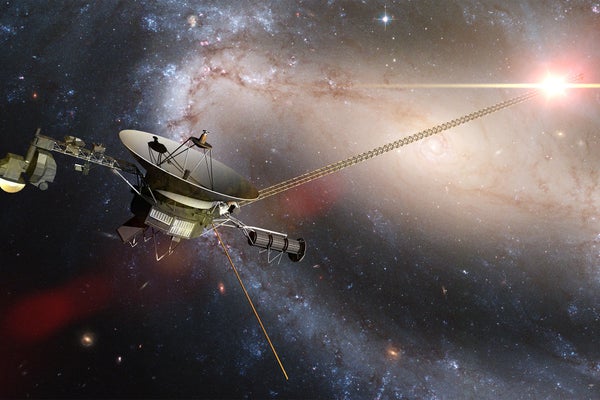
Artist's rendering of a Voyager spacecraft in deep space.
Dotted Zebra/Alamy Stock Photo
Amid April’s litany of bad news—war in Gaza, protests on American campuses, an impasse in Ukraine—a little uplift came for science buffs.
NASA has reestablished touch with Voyager 1 , the most distant thing built by our species, now hurtling through interstellar space far beyond the orbit of Pluto. The extraordinarily durable spacecraft had stopped transmitting data in November, but NASA engineers managed a very clever work-around, and it is sending data again. Now more than 15 billion miles away, Voyager 1 is the farthest human object, and continues to speed away from us at approximately 38,000 miles per hour.
Like an old car that continues to run, or an uncle blessed with an uncommonly long life, the robotic spacecraft is a super ager that goes on and on—and, in doing so, has captivated space buffs everywhere.
On supporting science journalism
If you're enjoying this article, consider supporting our award-winning journalism by subscribing . By purchasing a subscription you are helping to ensure the future of impactful stories about the discoveries and ideas shaping our world today.
Launched on September 5, 1977, the one-ton Voyager 1 was meant to chart the outer solar system, in particular the gas giant planets Jupiter and Saturn, and Saturn’s moon, Titan. Its twin, Voyager 2 , launched the same year, followed a different trajectory with a slightly different mission to explore the outer planets before heading to the solar system’s edge.
Those were NASA’s glory days. A few years earlier, NASA had successfully landed men on the moon—and won the space race for the U.S. NASA’s engineers were the envy of the world.
To get to Jupiter and Saturn, both Voyagers had to traverse the asteroid belt, which is full of rocks and debris orbiting the sun. They had to survive cosmic rays, intense radiation from Jupiter and other perils of space. But the two spacecraft made it without a hitch.
President Jimmy Carter held office when Voyager 1 was launched from Cape Canaveral; Elvis Presley had died just three weeks before; gas was about 60 cents a gallon; and, like now, the Middle East was in crisis, with Israeli Prime Minister Menachem Begin and Egyptian President Anwar Sadat trying to find peace.
Voyager 1 sent back spectacular photos of Jupiter and its giant red spot. It showed how dynamic the Jovian atmosphere was, with clouds and storms. It also took pictures of Jupiter’s moon Io, with its volcanoes, and Saturn’s moon Titan , which astronomers think has an atmosphere similar to the primordial Earth’s. The spacecraft discovered a thin ring around Jupiter and two new Jovian moons, which were named Thebe and Metis. On reaching Saturn, it discovered five new moons as well as a new ring.
And then Voyager 1 continued on its journey and sent images back from the edge of the solar system. Many of us remember the Pale Blue Dot , a haunting picture of the Earth it took on Feb 14, 1990, when it was a distance of 3.7 billion miles from the sun. The astronomer Carl Sagan wrote:
“There is perhaps no better demonstration of the folly of human conceits than this distant image of our tiny world. To me, it underscores our responsibility to deal more kindly with one another, and to preserve and cherish the pale blue dot, the only home we've ever known.”
By then Voyager 1 had long outlived its planetary mission but kept faithfully calling home as it traveled beyond the solar system into the realm of the stars. By 2012 Voyager 1 had reached the heliosphere , the farthest edge of the solar system. There, it penetrated the heliopause, where the solar wind ends, stopped by particles coming from the interstellar medium, the vast space between the stars. (Astronomers know that the space between the stars is not totally empty but permeated by a rarefied gas .)
From Voyager 1, scientists learned that the heliopause is quite dynamic and first measured the magnetic field of the Milky Way beyond the solar system. And its instruments kept sending data as it traveled through the interstellar medium.
On hearing that Voyager 1 had gone dark, I had checked in with Louis Lanzerotti , a former Bell Labs planetary scientist who did the calibrations for the Voyager 1 spacecraft and was a principal investigator on many experiments. He told me that a NASA manager in the 1970s had doubted that the spacecraft’s mechanical scan platform, which pointed instruments at targets, and very thin solid state detectors, which took those edge of the solar system readings, on the spacecraft would survive. They not only survived but worked flawlessly for all this time, Lanzerotti said, providing excellent data for decades. He was overjoyed on hearing the news that Voyager 1 was still alive.
Voyager 1 instruments have power until 2025 . After that, they will shut off, one by one. But there is nothing to stop the spacecraft as it speeds away from us in the vast emptiness of space.
Thousands of years from now, maybe when the human race has left this planet, Voyager 1, the tiny little spacecraft that could, will still continue its inexorable journey to the stars.
This is an opinion and analysis article, and the views expressed by the author or authors are not necessarily those of Scientific American.
Color Scheme
- Use system setting
- Light theme
Voyager 1, first craft in interstellar space, may have gone dark
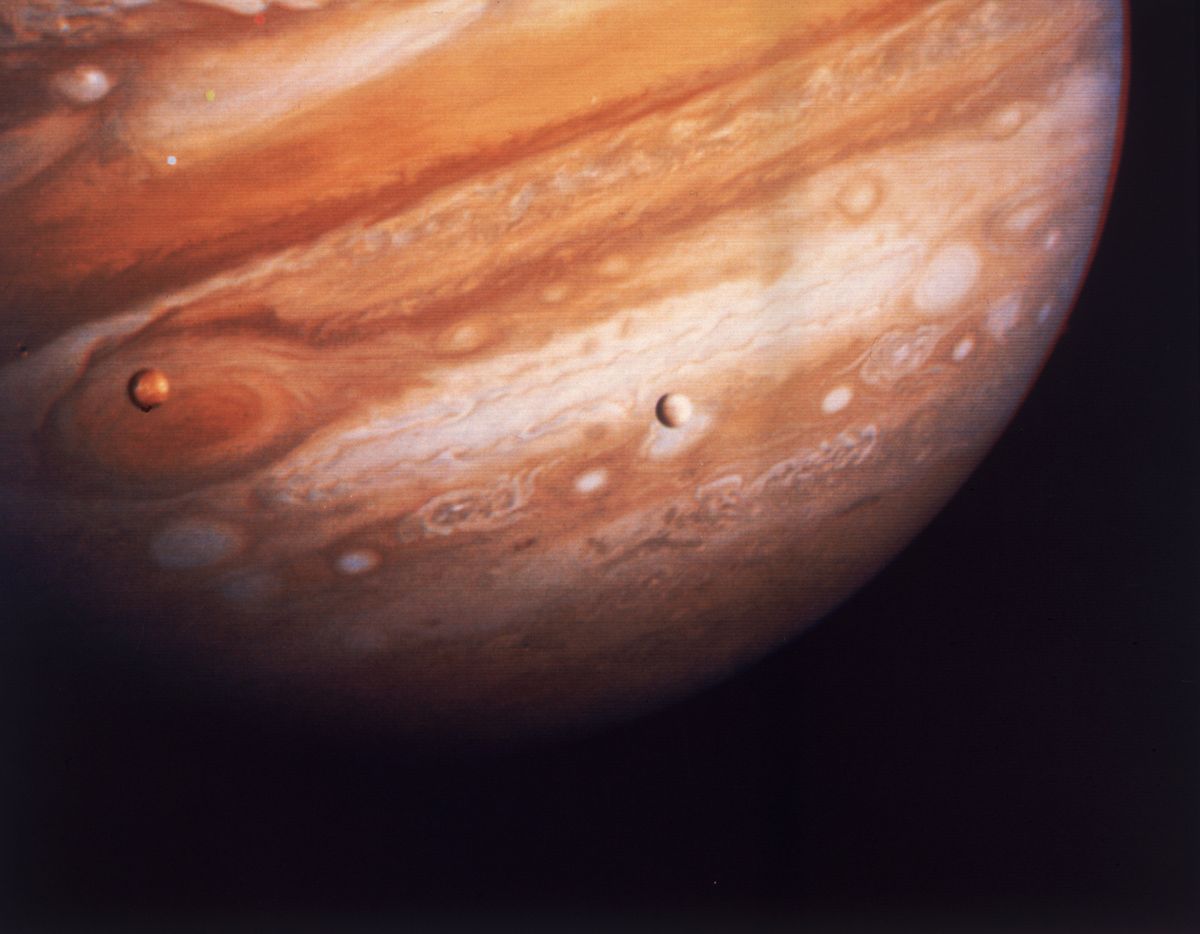
When Voyager 1 launched in 1977, scientists hoped it could do what it was built to do and take up-close images of Jupiter and Saturn. It did that – and much more.
Voyager 1 discovered active volcanoes, moons and planetary rings, proving along the way that Earth and all of humanity could be squished into a single pixel in a photograph, a “pale blue dot,” as astronomer Carl Sagan called it. It stretched a four-year mission into the present day, embarking on the deepest journey ever into space.
Now, it may have bid its final farewell to that faraway dot.
Voyager 1, the farthest human-made object in space, hasn’t sent coherent data to Earth since November. NASA has been trying to diagnose what the Voyager mission’s project manager, Suzanne Dodd, called the “most serious issue” the robotic probe has faced since she took the job in 2010.
The spacecraft encountered a glitch in one of its computers that has eliminated its ability to send engineering and science data back to Earth.
Voyager 1 is one half of the Voyager mission. It has a twin spacecraft, Voyager 2.
Launched in 1977, they were primarily built for a four-year trip to Jupiter and Saturn.
The 1980s flybys yielded new insights about the so-called great red spot on Jupiter, the rings around Saturn and the many moons of each planet.
Voyager 2 also explored Uranus and Neptune, becoming in 1989 the only spacecraft to explore all four outer planets.
Voyager 1, meanwhile, had set a course for deep space, using its camera to photograph the planets it was leaving behind along the way. Voyager 2 would later begin its own trek into deep space.
Before it went offline, Voyager 1 had been studying an anomalous disturbance in the magnetic field and plasma particles in interstellar space.
“Nothing else is getting launched to go out there,” Dodd said. “So that’s why we’re spending the time and being careful about trying to recover this spacecraft – because the science is so valuable.”
Recovery means getting under the hood of a spacecraft more than 15 billion miles away, equipped with the technology of yesteryear. It takes 45 hours to exchange information with the craft.
Voyager 2 is still operational. NASA had already estimated that the nuclear-powered generators of both spacecrafts would likely die around 2025.
This article originally appeared in The New York Times .
During the holidays, you may have noticed your parents need more help
After the holidays, you may find yourself facing the challenging reality that a beloved elderly family member or friend is experiencing cognitive or health decline.

Suggested Searches
- Climate Change
- Expedition 64
- Mars perseverance
- SpaceX Crew-2
- International Space Station
- View All Topics A-Z
Humans in Space
Earth & climate, the solar system, the universe, aeronautics, learning resources, news & events.
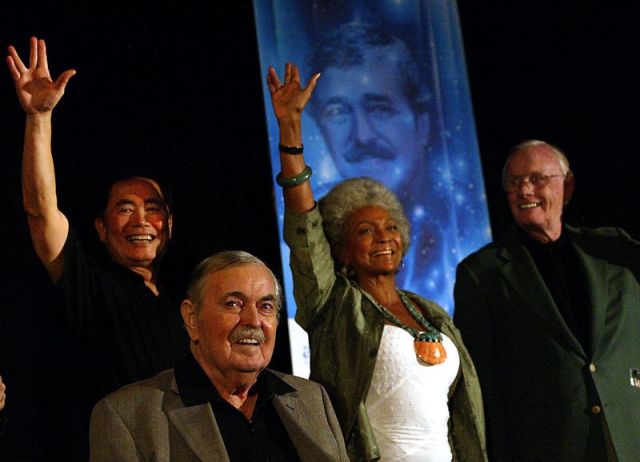
55 Years Ago: Star Trek Final Episode Airs, Relationship with NASA Endures

Space Station Research Advances NASA’s Plans to Explore the Moon, Mars

What’s Up: June 2024 Skywatching Tips from NASA
- Search All NASA Missions
- A to Z List of Missions
- Upcoming Launches and Landings
- Spaceships and Rockets
- Communicating with Missions
- James Webb Space Telescope
- Hubble Space Telescope
- Why Go to Space
- Commercial Space
- Destinations
- Living in Space
- Explore Earth Science
- Earth, Our Planet
- Earth Science in Action
- Earth Multimedia
- Earth Science Researchers
- Pluto & Dwarf Planets
- Asteroids, Comets & Meteors
- The Kuiper Belt
- The Oort Cloud
- Skywatching
- The Search for Life in the Universe
- Black Holes
- The Big Bang
- Dark Energy & Dark Matter
- Earth Science
- Planetary Science
- Astrophysics & Space Science
- The Sun & Heliophysics
- Biological & Physical Sciences
- Lunar Science
- Citizen Science
- Astromaterials
- Aeronautics Research
- Human Space Travel Research
- Science in the Air
- NASA Aircraft
- Flight Innovation
- Supersonic Flight
- Air Traffic Solutions
- Green Aviation Tech
- Drones & You
- Technology Transfer & Spinoffs
- Space Travel Technology
- Technology Living in Space
- Manufacturing and Materials
- Science Instruments
- For Kids and Students
- For Educators
- For Colleges and Universities
- For Professionals
- Science for Everyone
- Requests for Exhibits, Artifacts, or Speakers
- STEM Engagement at NASA
- NASA's Impacts
- Centers and Facilities
- Directorates
- Organizations
- People of NASA
- Internships
- Our History
- Doing Business with NASA
- Get Involved
- Aeronáutica
- Ciencias Terrestres
- Sistema Solar
- All NASA News
- Video Series on NASA+
- Newsletters
- Social Media
- Media Resources
- Upcoming Launches & Landings
- Virtual Events
- Sounds and Ringtones
- Interactives
- STEM Multimedia

Webb Finds Plethora of Carbon Molecules Around Young Star

NASA Scientists Take to the Seas to Study Air Quality

NASA to Change How It Points Hubble Space Telescope

NASA Astronauts Practice Next Giant Leap for Artemis

Former Astronaut David R. Scott

NASA Mission Flies Over Arctic to Study Sea Ice Melt Causes

Twin NASA Satellites Ready to Help Gauge Earth’s Energy Balance

Solid State Quantum Magnetometers—Seeking out water worlds from the quantum world

C.12 Planetary Instrument Concepts for the Advancement of Solar System Observations POC Change
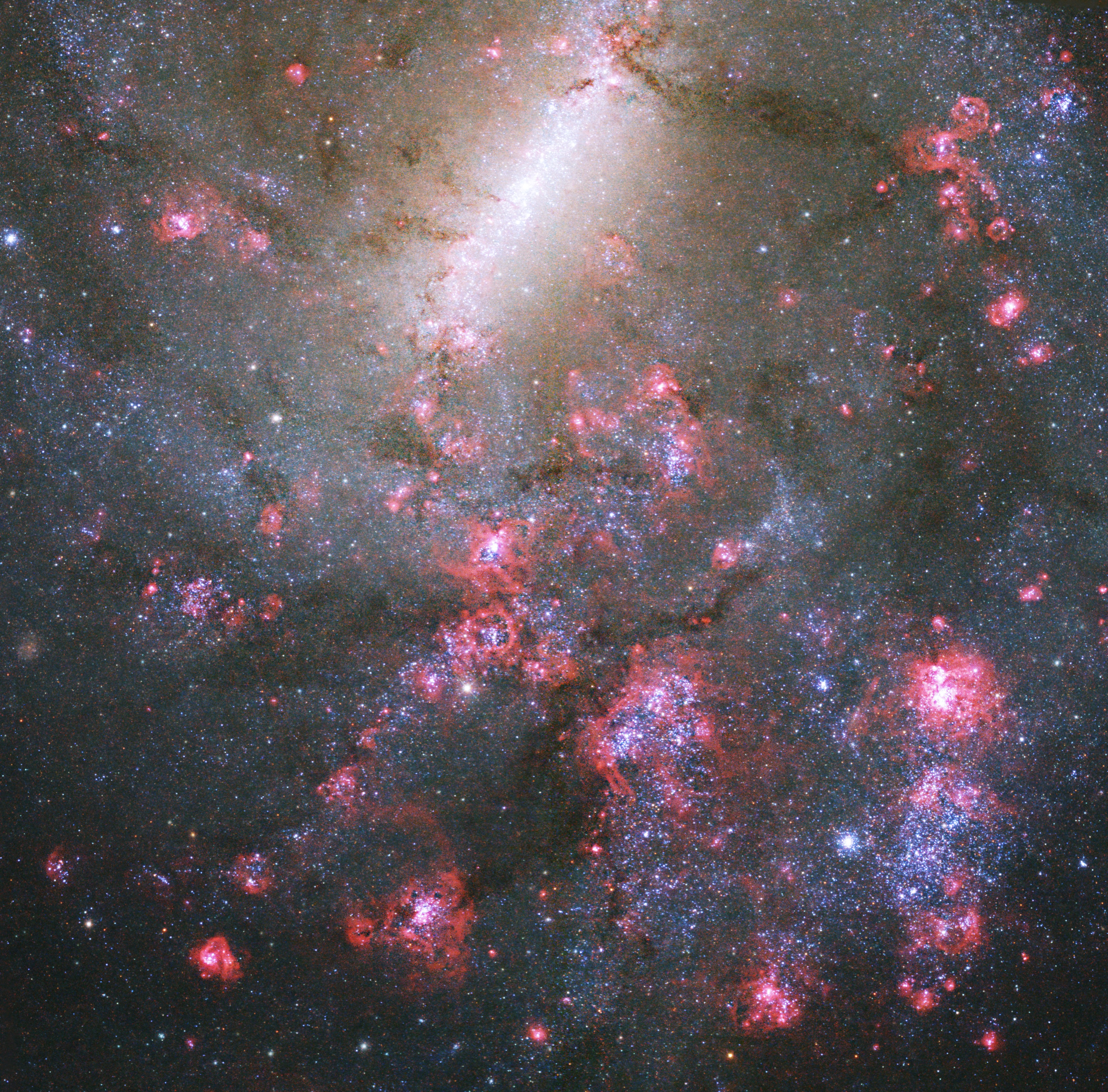
B.10 Heliophysics Flight Opportunities Studies Correction
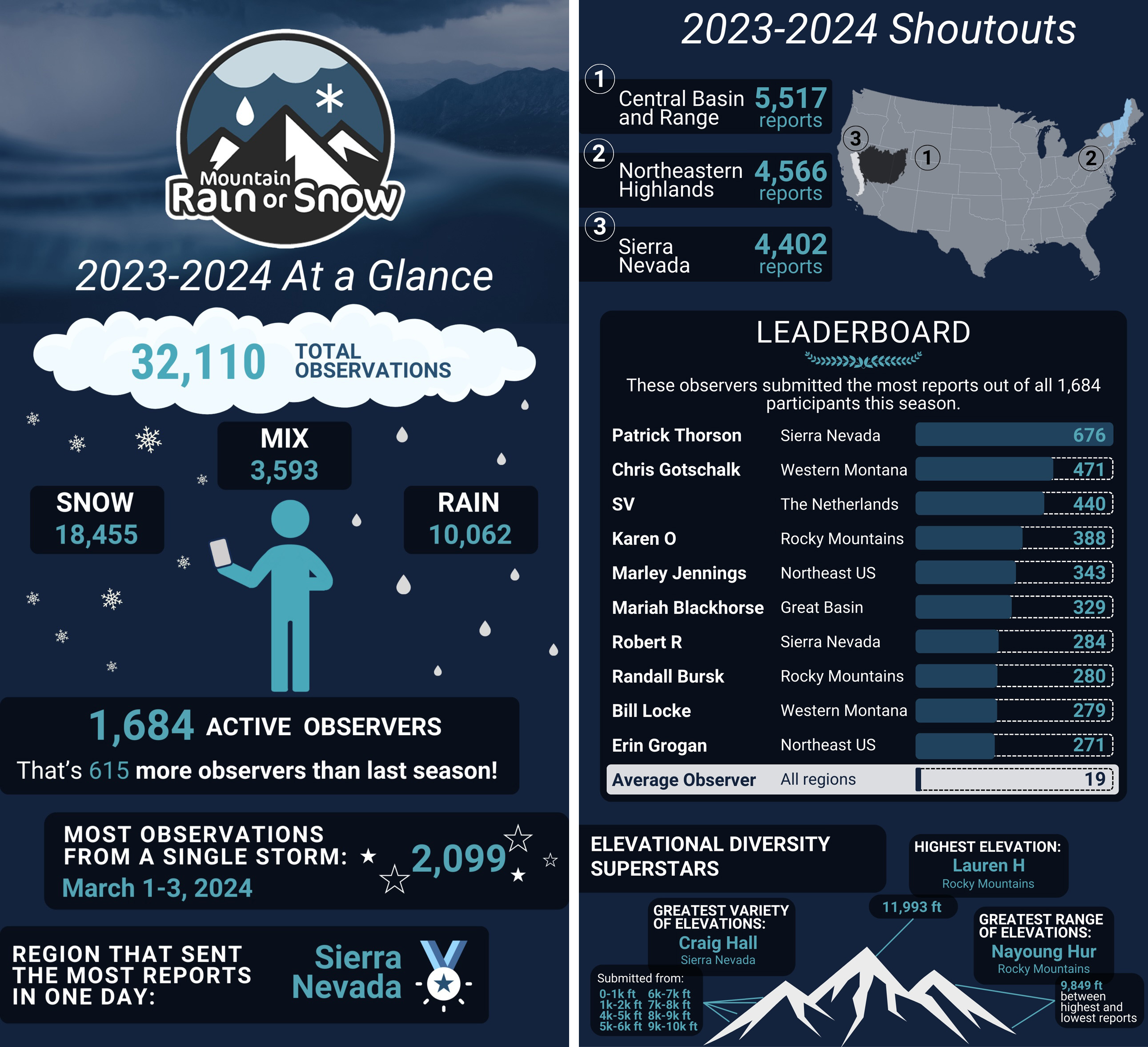
Mountain Rain or Snow Volunteers Broke Records This Winter

ARMD Solicitations

Winners Announced in Gateways to Blue Skies Aeronautics Competition

NASA, Industry to Start Designing More Sustainable Jet Engine Core

Tech Today: Measuring the Buzz, Hum, and Rattle

Artemis Generation Shines During NASA’s 2024 Lunabotics Challenge

Ames Science Directorate’s Stars of the Month, June 2024

Ted Michalek: Engineering from Apollo to Artemis
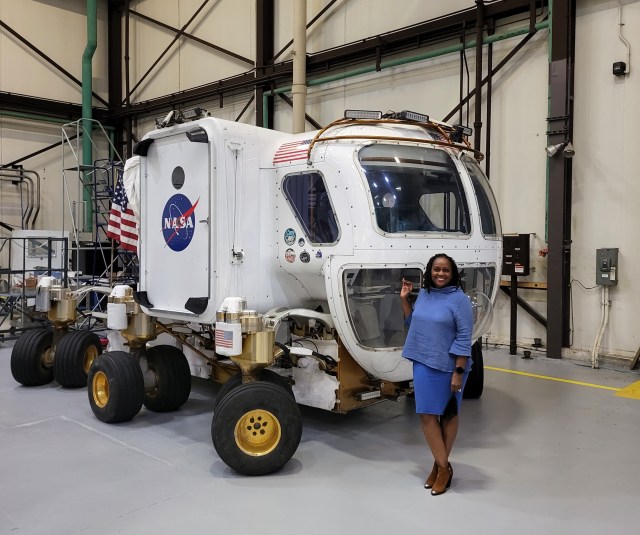
Aerospace Trailblazer: Shirley Holland-Hunt’s Visionary Leadership Transforms Space Exploration

Diez maneras en que los estudiantes pueden prepararse para ser astronautas

Astronauta de la NASA Marcos Berríos

Resultados científicos revolucionarios en la estación espacial de 2023
The marshall star for june 5, 2024.
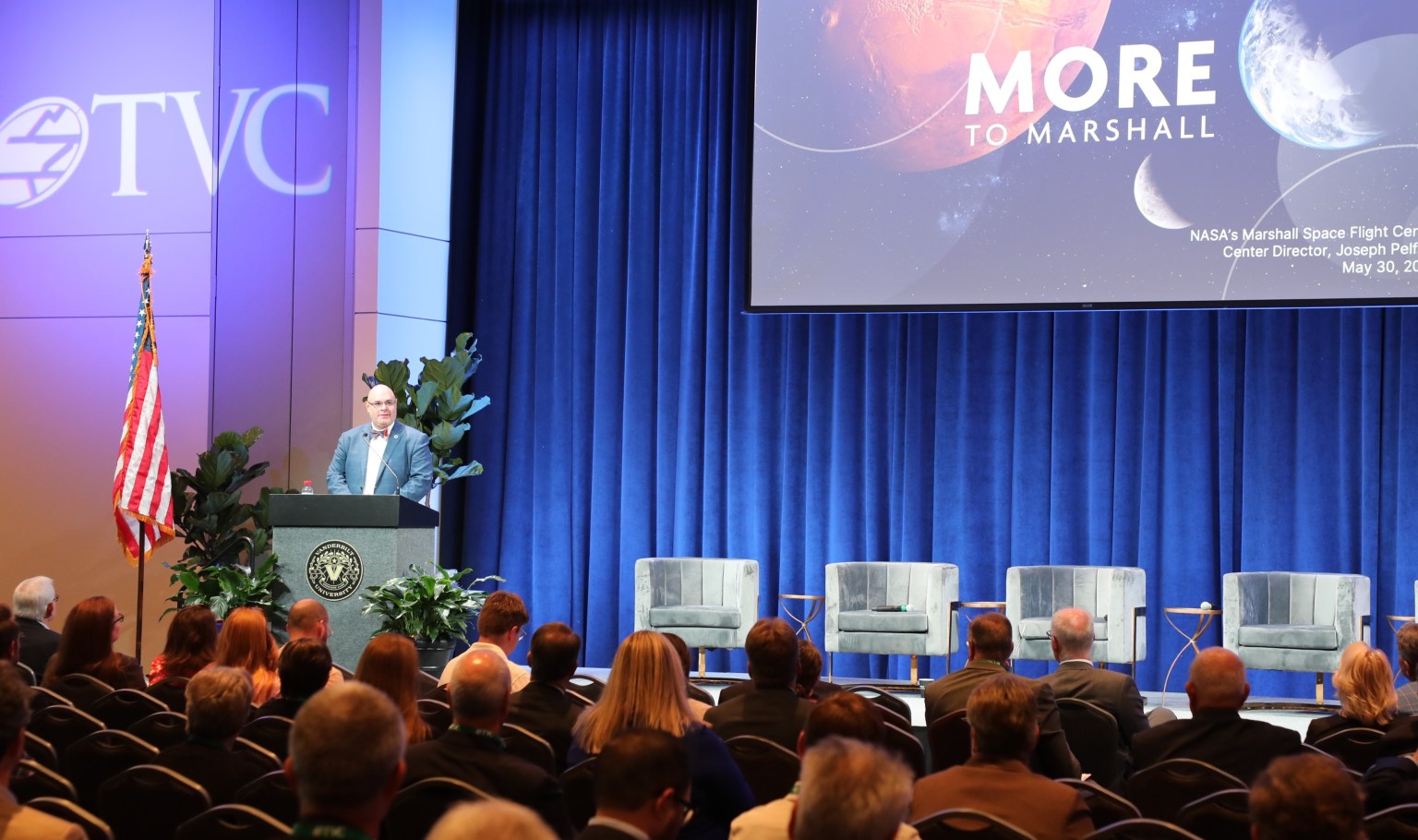
LIFTOFF! NASA Astronauts Pilot First Starliner Crewed Test to Station
Center director joseph pelfrey outlines marshall’s future at 29th tennessee valley corridor summit, davey jones named marshall’s center strategy lead, lucy images reveal asteroid dinkinesh to be surprisingly complex, nasa’s europa clipper unpacks in florida, travel through data from space in new 3d instagram experiences, agency to measure moonquakes with help from insight mars mission, nasa astronauts practice next giant leap for artemis.
NASA astronauts Butch Wilmore and Suni Williams are safely in orbit on the first crewed flight test aboard Boeing’s Starliner spacecraft bound for the International Space Station.
As part of NASA’s Boeing Crew Flight Test, the astronauts lifted off at 9:52 a.m. CDT June 5 on a ULA (United Launch Alliance) Atlas V rocket from Space Launch Complex-41 at Cape Canaveral Space Force Station on an end-to-end test of the Starliner system.

“Two bold NASA astronauts are well on their way on this historic first test flight of a brand-new spacecraft,” said NASA Administrator Bill Nelson. “Boeing’s Starliner marks a new chapter of American exploration. Human spaceflight is a daring task – but that’s why it’s worth doing. It’s an exciting time for NASA, our commercial partners, and the future of exploration. Go Starliner, Go Butch and Suni!”
As part of NASA’s Commercial Crew Program , the flight test will help validate the transportation system, launch pad, rocket, spacecraft, in-orbit operations capabilities, and return to Earth with astronauts aboard as the agency prepares to certify Starliner for rotational missions to the space station. Starliner previously flew two uncrewed orbital flights, including a test to and from the space station, along with a pad abort demonstration.
“With Starliner’s launch, separation from the rocket, and arrival on orbit, Boeing’s Crew Flight Test is right on track,” said Mark Nappi, vice president and program manager of Boeing’s Commercial Crew Program. “Everyone is focused on giving Suni and Butch a safe, comfortable, ride and performing a successful test mission from start to finish.”
During Starliner’s flight, Boeing will monitor a series of automatic spacecraft maneuvers from its mission control center in Houston. NASA teams will monitor space station operations throughout the flight from the Mission Control Center at the agency’s Johnson Space Center.
“Flying crew on Starliner represents over a decade of work by the Commercial Crew Program and our partners at Boeing and ULA,” said Steve Stich, manager, Commercial Crew Program, at NASA’s Johnson Space Center. “For many of us, this is a career-defining moment bringing on a new crew transportation capability for our agency and our nation. We are going to take it one step at a time, putting Starliner through its paces, and remaining vigilant until Butch and Suni safely touch down back on Earth at the conclusion of this test flight.”
Starliner will autonomously dock to the forward-facing port of the station’s Harmony module at approximately 11:15 a.m. June 6, and remain at the orbital laboratory for about a week.
Wilmore and Williams will help verify the spacecraft is performing as intended by testing the environmental control system, the displays and control system, and by maneuvering the thrusters, among other tests during flight.
After a safe arrival at the space station, Wilmore and Williams will join the Expedition 71 crew of NASA astronauts Michael Barratt, Matt Dominick, Tracy C. Dyson, and Jeanette Epps, and Roscosmos cosmonauts Nikolai Chub, Alexander Grebenkin, and Oleg Kononenko.
Mission coverage will continue on NASA Television channels throughout Starliner’s flight and resume on NASA+ prior to docking.
Follow mission updates here .
The Huntsville Operations Support Center (HOSC) at NASA’s Marshall Space Flight Center provides engineering and mission operations support for the space station, the Commercial Crew Program, and Artemis missions, as well as science and technology demonstration missions. The Payload Operations Integration Center within HOSC operates, plans, and coordinates the science experiments onboard the space station 365 days a year, 24 hours a day. The Commercial Crew Program support team at Marshall provides crucial programmatic, engineering, and safety and mission assurance expertise for launch vehicles, spacecraft propulsion, and integrated vehicle performance.
A flag-raising ceremony was held May 2 outside the HOSC for Marshall’s support of the mission. The ceremony was a joint effort between the Payload and Mission Operations Division and Commercial Crew Program team.
› Back to Top
By Rick Smith
Joseph Pelfrey, director of NASA’s Marshall Space Flight Center, was a key presenter at the 29th annual Tennessee Valley Corridor National Summit, hosted by Vanderbilt University in Nashville on May 29 and 30.
The event drew some 300 attendees, including government representatives, members of the public, and industry and academic stakeholders from across the corridor’s five-state region, which includes Alabama, Kentucky, North Carolina, Tennessee, and Virginia.
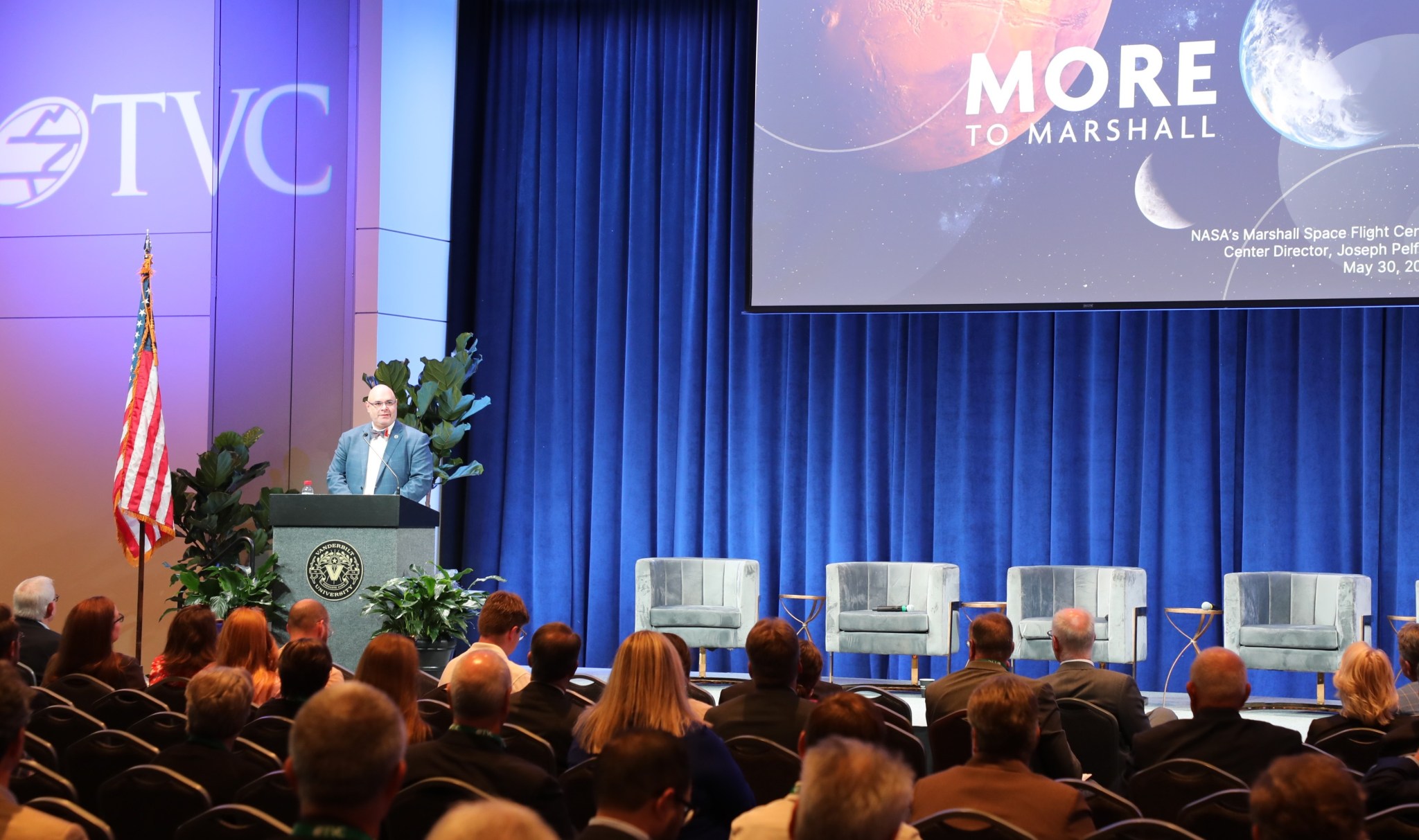
Pelfrey addressed summit attendees May 30 as part of a session on “Exploring and Discovering Through Science, Research, and Space.” He noted that Marshall will embrace a transformative shift, including a transition toward small- and medium-sized programs enabled by strategic partnerships, helping NASA prepare for a future in which astronauts live and work on the Moon and prepare for crewed missions to Mars.
That paradigm shift will rely heavily on “the talent, innovation, and infrastructure available in the Tennessee Valley, (enabling) us to accelerate progress in space exploration, scientific research, and technology development,” Pelfrey added.
He also emphasized that there is much more to come for Marshall, with the center continuing to serve as a trusted technical solutions provider for NASA and its partners. Pelfrey highlighted how harnessing the center’s deep technical expertise for future missions will help drive innovation, reduce costs, and accelerate shared goals for advanced space exploration.
Pelfrey offered a detailed look at NASA’s successful Artemis I launch in 2022 and the upcoming Artemis II mission, which will send the first woman and first person of color to deep space to conduct a lunar fly-by – the final checkout before Artemis III lands Americans on the lunar surface for the first time since 1972. Pelfrey also discussed Marshall’s role in managing NASA’s SLS ( Space Launch System ) rocket, the backbone of the agency’s Artemis-era endeavors, and identified new and upcoming programs and efforts geared to expand the center’s role in deep-space science and exploration.
He noted that much of that work has had a direct effect on the state of Tennessee and on industry and academia across the corridor.
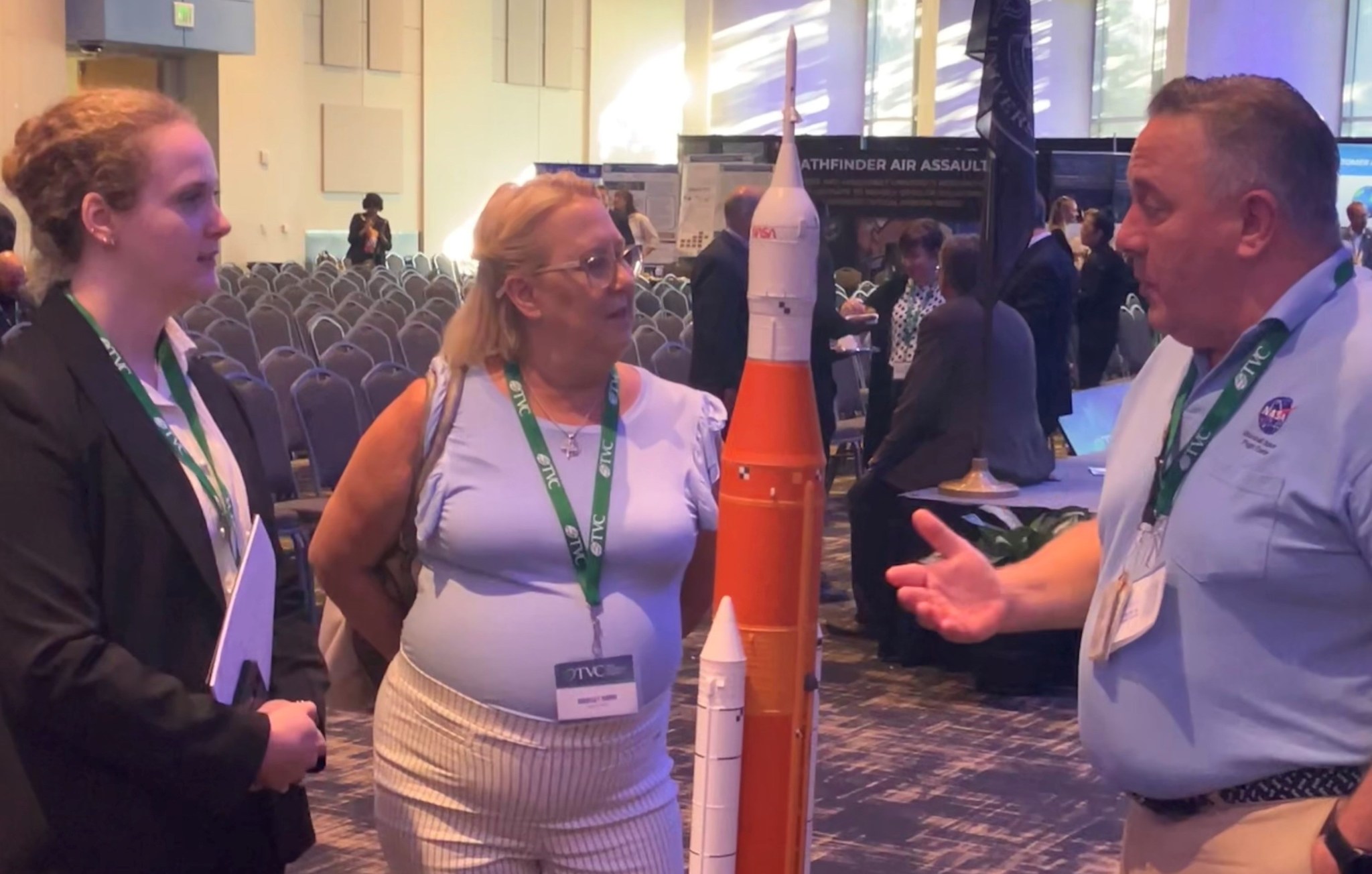
In fiscal year 2021 alone, NASA’s economic impact supported more than 1,600 jobs and generated more than $340 million in Tennessee alone, including $119 million in labor income. More broadly, since 2015, NASA has enacted 97 Cooperative Agreements with partners across the five-state corridor. Eighty-two of those were with universities, including six minority-serving institutions. Of the 15 industry agreements, 11 created partnerships with small businesses.
“This is truly an exciting time to live and work in the Tennessee Valley,” Pelfrey said, “and to be part of the space community.”
Other summit speakers included Senators Marsha Blackburn and Bill Hagerty of Tennessee, Rep. Chuck Fleischmann of Tennessee’s 3rd district, and Rep. Mark Green of Tennessee’s 7th district; Corey Hinderstein, deputy administrator of the National Nuclear Security Administration; Dr. Steven Streiffer, director of Oak Ridge National Laboratory; and Dr. Robert Lindquist, vice president for research and economic development at the University of Alabama in Huntsville.
Panels and seminars included discussion of American security, global economic leadership, new energy solutions, workforce development, and the emergence of AI technology. More than 20 businesses and academic institutions – including representatives from SLS, the Human Landing Systems Program Office , the Space Nuclear Propulsion Project Office , and other Marshall organizations – engaged with summit participants and promoted current and future NASA endeavors at a trade-show expo in the Vanderbilt Student Life Center.
The Tennessee Valley Corridor was founded in 1995 to foster collaboration between government, academia, and industry, to champion regional economic leadership, and to promote partnerships in national security, science, space, transportation, environment, energy, education, and workforce development. Its 2023 national summit was held in Huntsville.
Smith, an Aeyon/MTS employee, supports the Marshall Office of Communications.
Davey Jones has been named center strategy lead at NASA’s Marshall Space Flight Center, following the reassignment of Jeramie Broadway, effective June 2.
As center strategy lead for the Office of the Center Director, Jones will lead and implement the director’s strategic vision, leveraging and integrating Marshall’s strategic business units, in coordination and collaboration with all center organizations, and to ensure alignment with the agency’s strategic priorities.
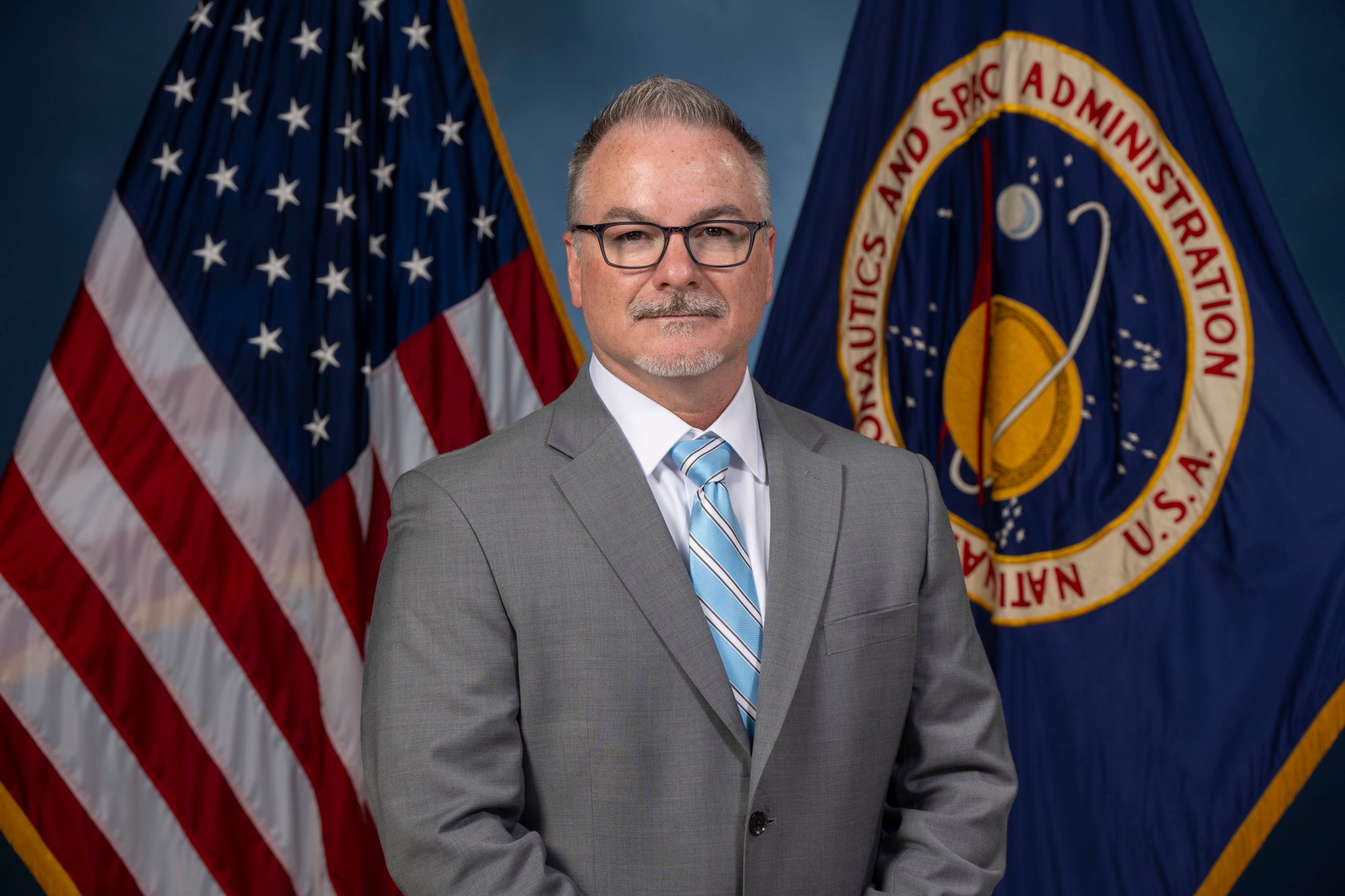
He moves into his new role after being the manager of the Program Planning & Control Office within the HLS (Human Landing Systems) Program at Marshall since 2020. In that capacity, Jones’ primary role was managing the program’s budget, schedule, risk, and other programmatic functions. He has worked in multiple roles throughout his career, focused on the formulation of key programs and projects for Marshall, including development of technology upgrades for life support systems on the International Space Station, formulation of the SLS (Space Launch System) Block 1B vehicle and exploration upper stage, and leading various human exploration architecture studies for the Moon and Mars.
From 2017 to 2020, he was the Environmental Control and Life Support System Integration and Development manager for the International Space Station Projects Office in the Human Exploration Development and Operations Office. Jones was senior technical assistant to Marshall’s associate director, technical, from 2016-2017. Prior to that, he was SLS stages alternate lead systems engineer from 2014-2016. A U.S. Navy veteran, he began his NASA career in 2008 in the Advanced Concepts Office.
Jones’ honors include a NASA Early Career Achievement Medal, Marshall Engineering Director’s Award, and a Human Exploration Framework Team Group Achievement Award.
A native of Lakeland, Florida, he earned a bachelor’s degree in mechanical engineering from the University of Alabama in Huntsville.
Images from the November 2023 flyby of asteroid Dinkinesh by NASA’s Lucy spacecraft show a trough on Dinkinesh where a large piece – about a quarter of the asteroid – suddenly shifted, a ridge, and a separate contact binary satellite (now known as Selam). Scientists say this complicated structure shows that Dinkinesh and Selam have significant internal strength and a complex, dynamic history.
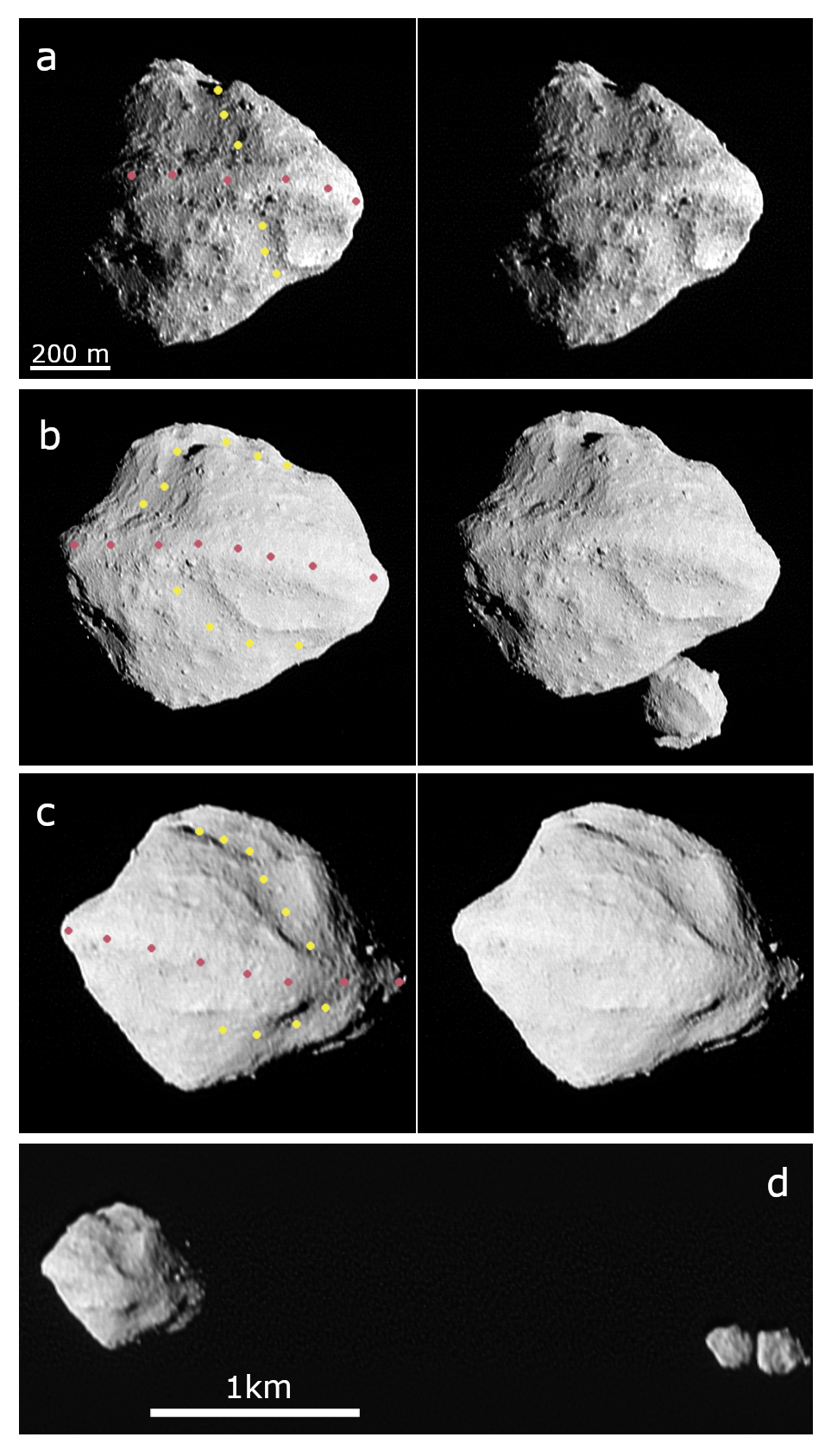
“We want to understand the strengths of small bodies in our solar system because that’s critical for understanding how planets like Earth got here,” said Hal Levison, Lucy principal investigator at the Boulder, Colorado, branch of the Southwest Research Institute in San Antonio, Texas. “Basically, the planets formed when zillions of smaller objects orbiting the Sun, like asteroids, ran into each other. How objects behave when they hit each other, whether they break apart or stick together, has a lot to do with their strength and internal structure.” Levison is lead author of a paper on these observations published May 29 in Nature.
Researchers think that Dinkinesh is revealing its internal structure by how it has responded to stress. Over millions of years rotating in the sunlight, the tiny forces coming from the thermal radiation emitted from the asteroid’s warm surface generated a small torque that caused Dinkinesh to gradually rotate faster, building up centrifugal stresses until part of the asteroid shifted into a more elongated shape. This event likely caused debris to enter into a close orbit, which became the raw material that produced the ridge and satellite.
If Dinkinesh were much weaker, more like a fluid pile of sand, its particles would have gradually moved toward the equator and flown off into orbit as it spun faster. However, the images suggest that it was able to hold together longer, more like a rock, with more strength than a fluid, eventually giving way under stress and fragmenting into large pieces. (Although the amount of strength needed to fragment a small asteroid like Dinkinesh is miniscule compared to most rocks on Earth.)
“The trough suggests an abrupt failure, more an earthquake with a gradual buildup of stress and then a sudden release, instead of a slow process like a sand dune forming,” said Keith Noll of NASA’s Goddard Space Flight Center, project scientist for Lucy and a co-author of the paper.
“These features tell us that Dinkinesh has some strength, and they let us do a little historical reconstruction to see how this asteroid evolved,” Levison said. “It broke, things moved apart and formed a disk of material during that failure, some of which rained back onto the surface to make the ridge.”
The researchers think some of the material in the disk formed the moon Selam, which is actually two objects touching each other , a configuration called a contact binary. Details of how this unusual moon formed remain mysterious.
Dinkinesh and its satellite are the first two of 11 asteroids that Lucy’s team plans to explore over its 12-year journey. After skimming the inner edge of the main asteroid belt, Lucy is now heading back toward Earth for a gravity assist in December 2024. That close flyby will propel the spacecraft back through the main asteroid belt, where it will observe asteroid Donaldjohanson in 2025, and then on to the first of the encounters with the Trojan asteroids that lead and trail Jupiter in its orbit of the Sun beginning in 2027.
Lucy’s principal investigator is based out of the Boulder, Colorado, branch of Southwest Research Institute, headquartered in San Antonio. NASA’s Goddard Space Flight Center provides overall mission management, systems engineering, and safety and mission assurance. Lockheed Martin Space in Littleton, Colorado, built and operates the spacecraft. Lucy is the 13th mission in NASA’s Discovery Program. NASA’s Marshall Space Flight Center manages the Discovery Program for the Science Mission Directorate at NASA Headquarters.
Crews rotated to vertical then lifted NASA’s Europa Clipper spacecraft from its protective shipping container after it arrived at the Payload Hazardous Servicing Facility at the agency’s Kennedy Space Center on May 28.
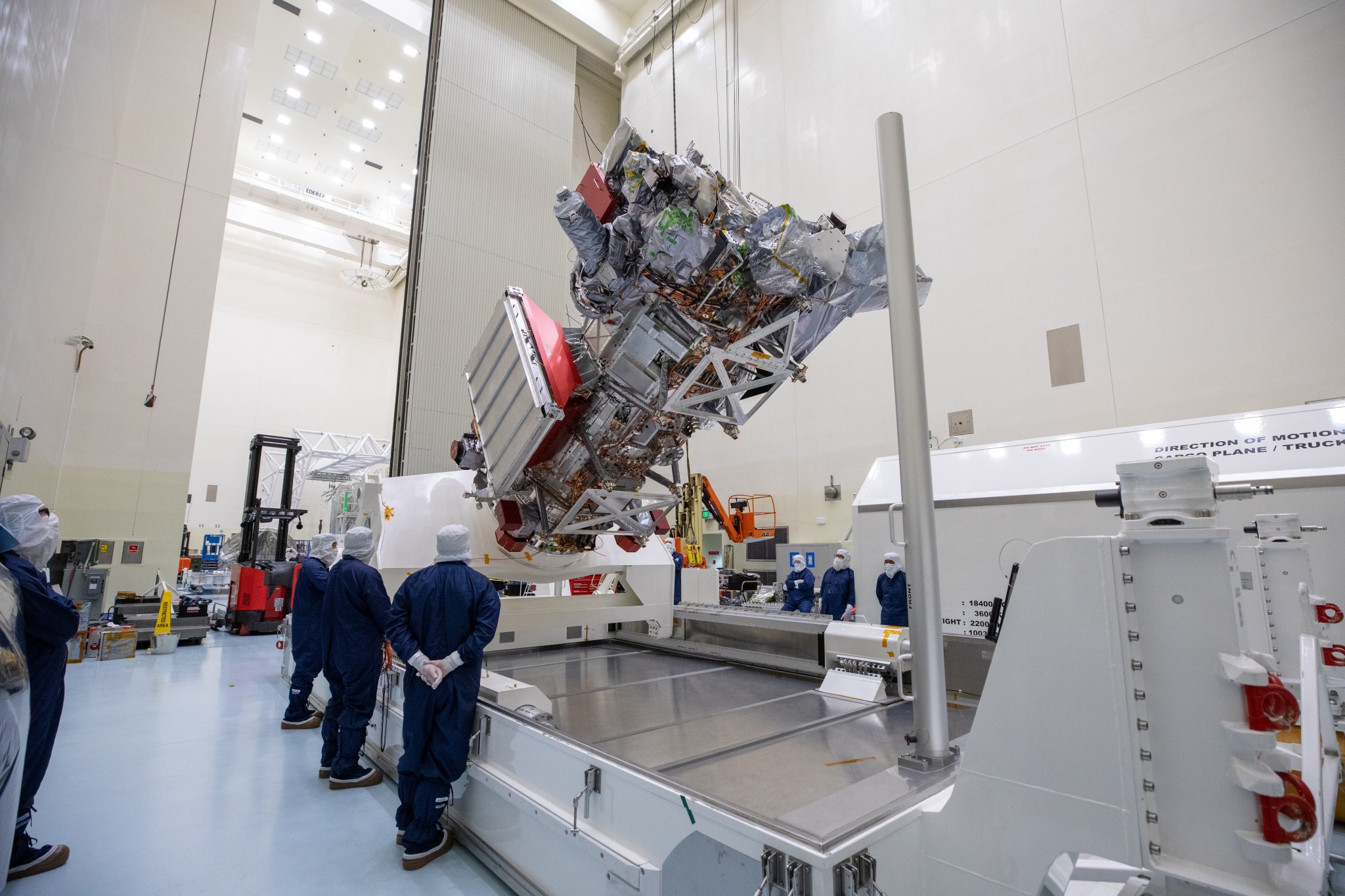
The spacecraft, which will collect data to help scientists determine if Jupiter’s icy moon Europa could support life, arrived in a United States Air Force C-17 Globemaster III cargo plane at Kennedy’s Launch and Landing Facility on May 23. The hardware traveled more than 2,500 miles from NASA’s Jet Propulsion Lab in Southern California where it was assembled. The team transported Europa Clipper to the facility and will perform a number of activities to prepare it for launch, including attaching the high gain antenna, affixing solar arrays to power the spacecraft, and loading propellants that will help guide the spacecraft to its destination.
On board are nine science instruments to gather detailed measurements while Europa Clipper performs approximately 50 close flybys of the Jovian moon. Research suggests an ocean twice the volume of all the Earth’s oceans exists under Europa’s icy crust.
The Europa Clipper spacecraft will launch on a SpaceX Falcon Heavy rocket from NASA Kennedy’s Launch Complex 39A. The launch period opens Oct. 10.
Managed by Caltech in Pasadena, California, JPL leads the development of the Europa Clipper mission in partnership with the Johns Hopkins Applied Physics Laboratory (APL) in Laurel, Maryland, for NASA’s Science Mission Directorate. APL designed the main spacecraft body in collaboration with JPL and NASA’s Goddard Space Flight Center. The Planetary Missions Program Office at NASA’s Marshall Space Flight Center executes program management of the Europa Clipper mission.
A new project provides special 3D “experiences” on Instagram using data from NASA’s Chandra X-ray Observatory and other telescopes through augmented reality (AR), allowing users to travel virtually through objects in space. These new experiences of astronomical objects – including the debris fields of exploded stars – are being released to help celebrate the 25 th anniversary of operations from Chandra, NASA’s flagship X-ray telescope.
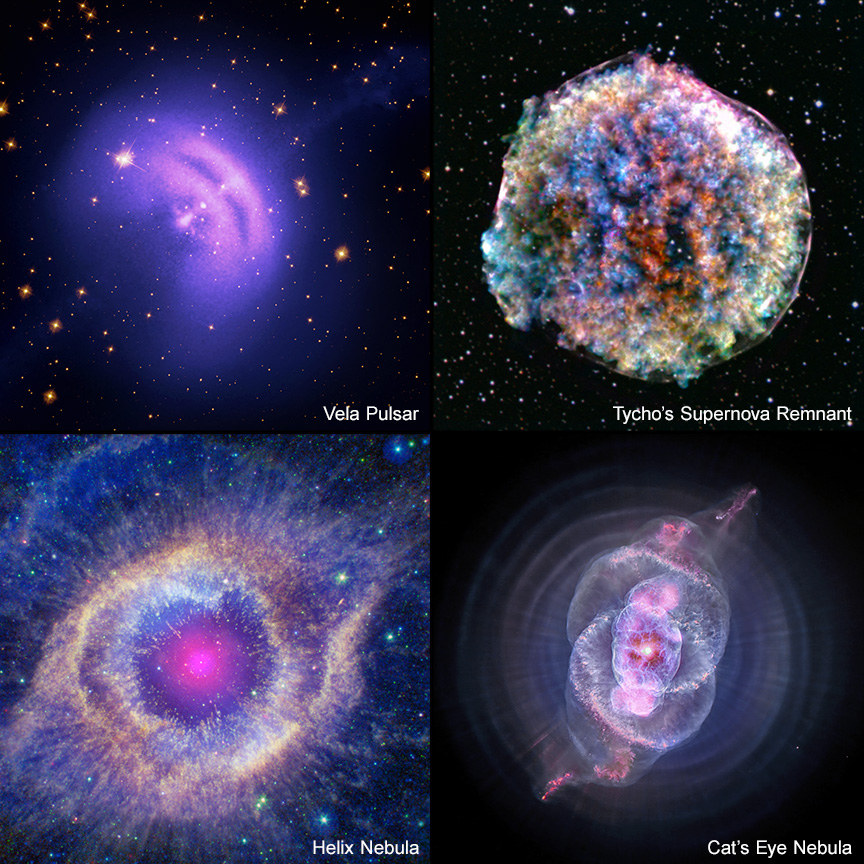
In recent years, Instagram experiences (previously referred to as filters) of NASA mission control, the International Space Station, and the Perseverance Rover on Mars have allowed participants to virtually explore what NASA does. This new set of Chandra Instagram filters joins this space-themed collection.
“We are excited to bring data from the universe down to earth in this way,” said Kimberly Arcand, visualization and emerging technology scientist at the Chandra X-ray Center. “By enabling people to access cosmic data on their phones and through AR, it brings Chandra’s amazing discoveries literally right to your fingertips.”
The new Instagram experiences are created from 3D models based on data collected by Chandra and other telescopes along with mathematical models. Traditionally, it has been very difficult to gather 3D data of objects in our galaxy due to their two-dimensional projection on the sky. New instruments and techniques, however, have helped allowed astronomers in recent years to construct more data-driven models of what these distant objects look like in three dimensions.
These advancements in astronomy have paralleled the explosion of opportunities in virtual, extended, and augmented reality. Such technologies provide virtual digital experiences, which now extend beyond Earth and into the cosmos. This new set of Chandra Instagram experiences was made possible by a collaboration including NASA, the Smithsonian Institution, and students and researchers at Brown University.
These Instagram experiences also include data sonifications of the celestial objects. Sonification is the process of translating data into sounds and notes so users can hear representations of the data, an accessibility project the Chandra team has led for the past four years.
“These Chandra Instagram experiences are another way to share these cosmic data with the public,” Arcand said. “We are hoping this helps reach new audiences, especially those who like to get their information through social media.”
The objects in the new Chandra Instagram experience collection include the Tycho supernova remnant, the Vela Pulsar, the Helix Nebula, the Cat’s Eye Nebula, and the Chandra spacecraft. The 3D models of the first three objects were done in conjunction with Sal Orlando, an astrophysicist at Italy’s National Institute for Astrophysics (INAF) in Palmero. The Cat’s Eye Nebula was created with data from Ryan Clairmont, physics researcher and undergraduate at Stanford University. Arcand worked with Brown’s Tom Sgouros and his team, research assistant Alexander Dupuis and undergraduate Healey Koch, on the Chandra Instagram filters.
The experiences include text that explains what users are looking at. The effects are free and available on Instagram on mobile devices for at least six months, and some will remain viewable in perpetuity on the Smithsonian’s Voyager 3D website.
“There is a lot of rich and beautiful data associated with these models that Healey and I looked to bring in, which we did by creating the textures on the models as well as programming visual effects for displaying them in AR,” Dupuis said.
NASA’s Marshall Space Flight Center manages the Chandra program. The Smithsonian Astrophysical Observatory’s Chandra X-ray Center controls science from Cambridge Massachusetts and flight operations from Burlington, Massachusetts. The Chandra X-ray Center is headquartered at the Smithsonian Astrophysical Observatory, which is part of the Center for Astrophysics | Harvard & Smithsonian.
Read more from NASA’s Chandra X-ray Observatory.
The most sensitive instrument ever built to measure quakes and meteor strikes on other worlds is getting closer to its journey to the mysterious far side of the Moon. It’s one of two seismometers adapted for the lunar surface from instruments originally designed for NASA’s InSight Mars lander, which recorded more than 1,300 marsquakes before the mission’s conclusion in 2022.
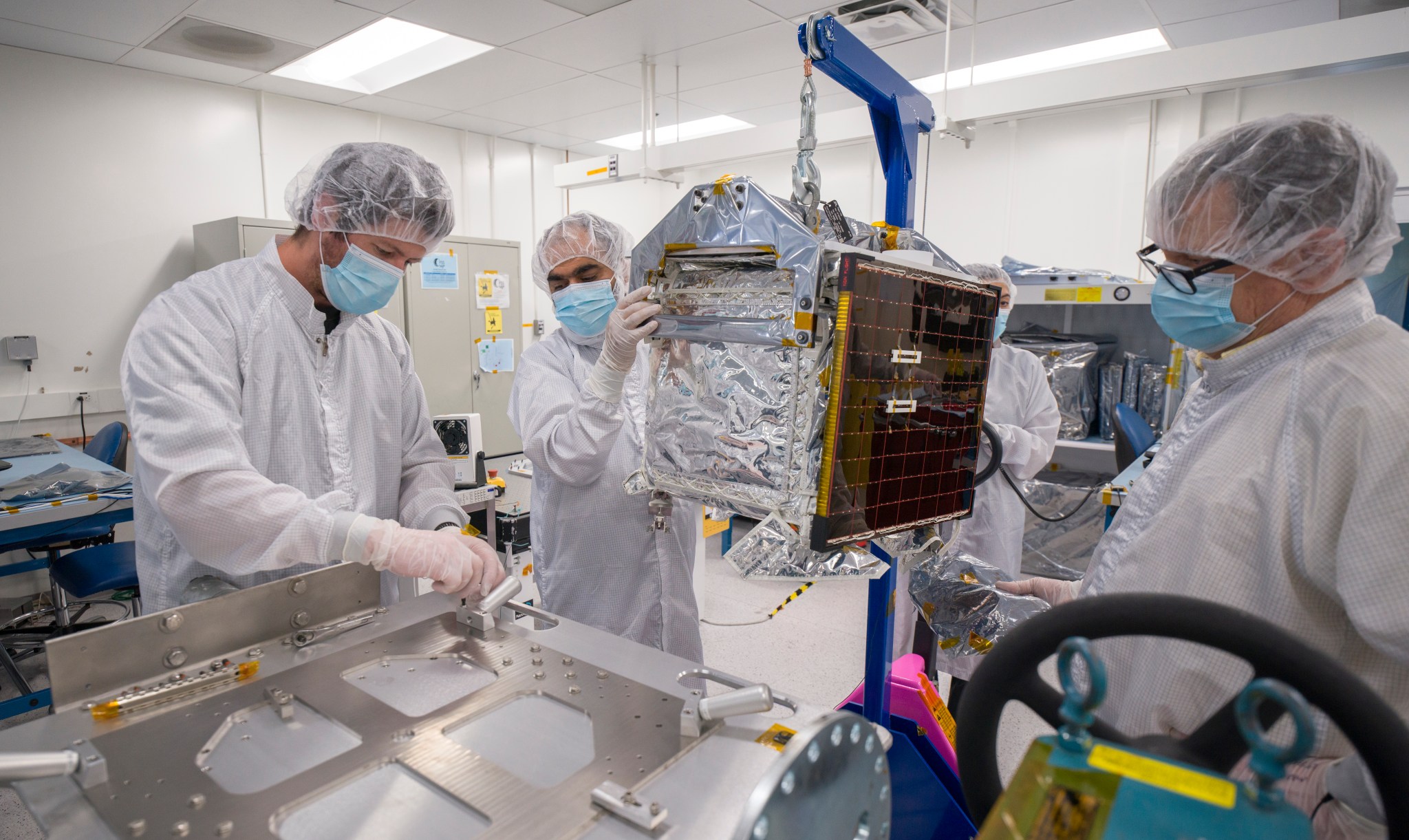
Part of a payload called Farside Seismic Suite (FSS) that was recently assembled at NASA’s Jet Propulsion Laboratory, the two seismometers are expected to arrive in 2026 at Schrödinger basin, a wide impact crater about 300 miles from the Moon’s South Pole. The self-sufficient, solar-powered suite has its own computer and communications equipment, plus the ability to protect itself from the extreme heat of lunar daytime and the frigid conditions of night.
After being delivered to the surface by a lunar lander under NASA’s CLPS (Commercial Lunar Payload Services) initiative, the suite will return the agency’s first seismic data from the Moon since the last Apollo program seismometers were in operation nearly 50 years ago. Not only that, but it will also provide the first-ever seismic measurements from the Moon’s far side.
Up to 30 times more sensitive than its Apollo predecessors, the suite will record the Moon’s seismic “background” vibration, which is driven by micrometeorites the size of small pebbles that pelt the surface. This will help NASA better understand the current impact environment as the agency prepares to send Artemis astronauts to explore the lunar surface.
Planetary scientists are eager to see what FSS tells them about the Moon’s internal activity and structure. What they learn will offer insights into how the Moon – as well as rocky planets like Mars and Earth – formed and evolved.
It will also answer a lingering question about moonquakes: Why did the Apollo instruments on the lunar near side detect little far-side seismic activity? One possible explanation is that something in the Moon’s deep structure essentially absorbs far-side quakes, making them harder for Apollo’s seismometers to have sensed. Another is that there are fewer quakes on the far side, which on the surface looks very different from the side that faces Earth.
“FSS will offer answers to questions we’ve been asking about the Moon for decades,” said Mark Panning, the FSS principal investigator at JPL and project scientist for InSight. “We cannot wait to start getting this data back.”
Farside Seismic Suite’s two complementary instruments were adapted from InSight designs to perform in lunar gravity – less than half that of Mars, which, in turn, is about a third of Earth’s. They’re packaged together with a battery, the computer, and electronics inside a cube structure that’s surrounded by insulation and an outer protective cube. Perched atop the lander, the suite will gather data continuously for at least 4½ months, operating through the long, cold lunar nights.
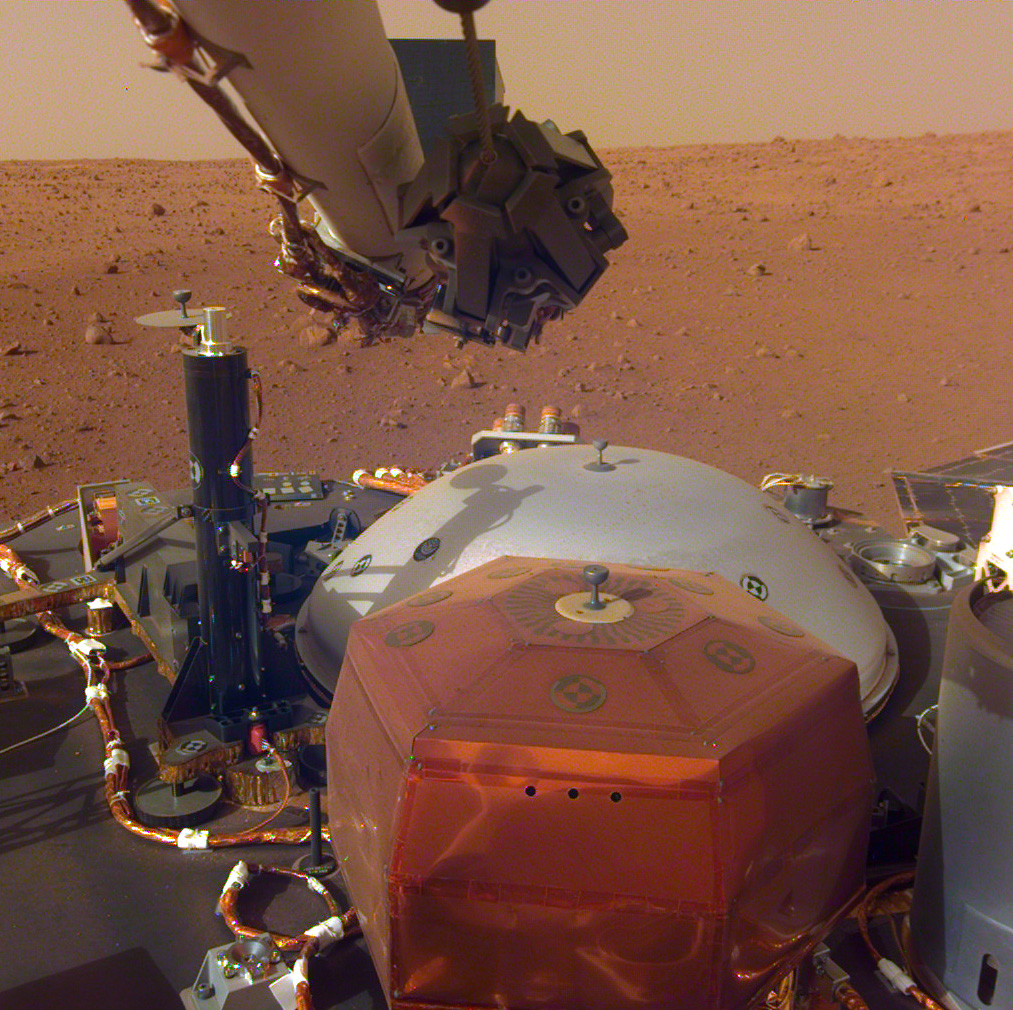
The Very Broadband seismometer, or VBB, is the most sensitive seismometer ever built for use in space exploration: It can detect ground motions smaller than the size of a single hydrogen atom. A fat cylinder about 5 inches in diameter, it measures up-and-down movement using a pendulum held in place by a spring. It was originally constructed as an emergency replacement instrument (a “flight spare”) for InSight by the French space agency, CNES (Centre National d’Études Spatiales).
Philippe Lognonné of Institut de Physique du Globe de Paris, the principal investigator for InSight’s seismometer , is an FSS co-investigator and VBB instrument lead. “We learned so much about Mars from this instrument, and now we are thrilled with the opportunity to turn that experience toward the mysteries of the Moon,” he said.
The suite’s smaller seismometer, called the Short Period sensor, or SP, was built by Kinemetrics in Pasadena, California, in collaboration with the University of Oxford and Imperial College, London. The puck-shaped device measures motion in three directions using sensors etched into a trio of square silicon chips each about 1 inch wide.
The FSS payload came together at JPL over the last year. In recent weeks, it survived rigorous environmental testing in vacuum and extreme temperatures that simulate space, along with severe shaking that mimics the rocket’s motion during launch.
“The JPL team has been excited from the beginning that we’re going to the Moon with our French colleagues,” said JPL’s Ed Miller, FSS project manager and, like Panning and Lognonné, a veteran of the InSight mission. “We went to Mars together, and now we’ll be able to look up at the Moon and know we built something up there. It’ll make us so proud.”
A division of Caltech in Pasadena, California, JPL manages, designed, assembled, and tested Farside Seismic Suite. The French space agency, CNES (Centre National d’Études Spatiales), and IPGP (Institut de Physique du Globe de Paris) provided the suite’s Very Broadband seismometer with support from Université Paris Cité and the CNRS (Centre National de la Recherche Scientifique). Imperial College, London and the University of Oxford collaborated to provide the Short Period sensor, managed by Kinemetrics in Pasadena. The University of Michigan provided the flight computer, power electronics, and associated software.
A selection of NASA’s PRISM (Payloads and Research Investigations on the Surface of the Moon), FSS is funded by the Exploration Science Strategy and Integration Office within the agency’s Science Mission Directorate. The Planetary Missions Program Office at NASA’s Marshall Space Flight Center provides program management. FSS will land on the Moon as part of an upcoming lunar delivery under NASA’s CLPS ( Commercial Lunar Payload Services ) initiative.
The physics remain the same, but the rockets, spacecraft, landers, and spacesuits are new as NASA and its industry partners prepare for Artemis astronauts to walk on the Moon for the first time since 1972.
NASA astronaut Doug “Wheels” Wheelock and Axiom Space astronaut Peggy Whitson put on spacesuits, developed by Axiom Space , to interact with and evaluate full-scale developmental hardware of SpaceX’s Starship HLS (Human Landing System) that will be used for landing humans on the Moon under Artemis. The test, conducted April 30, marked the first time astronauts in pressurized spacesuits interacted with a test version of Starship HLS hardware.
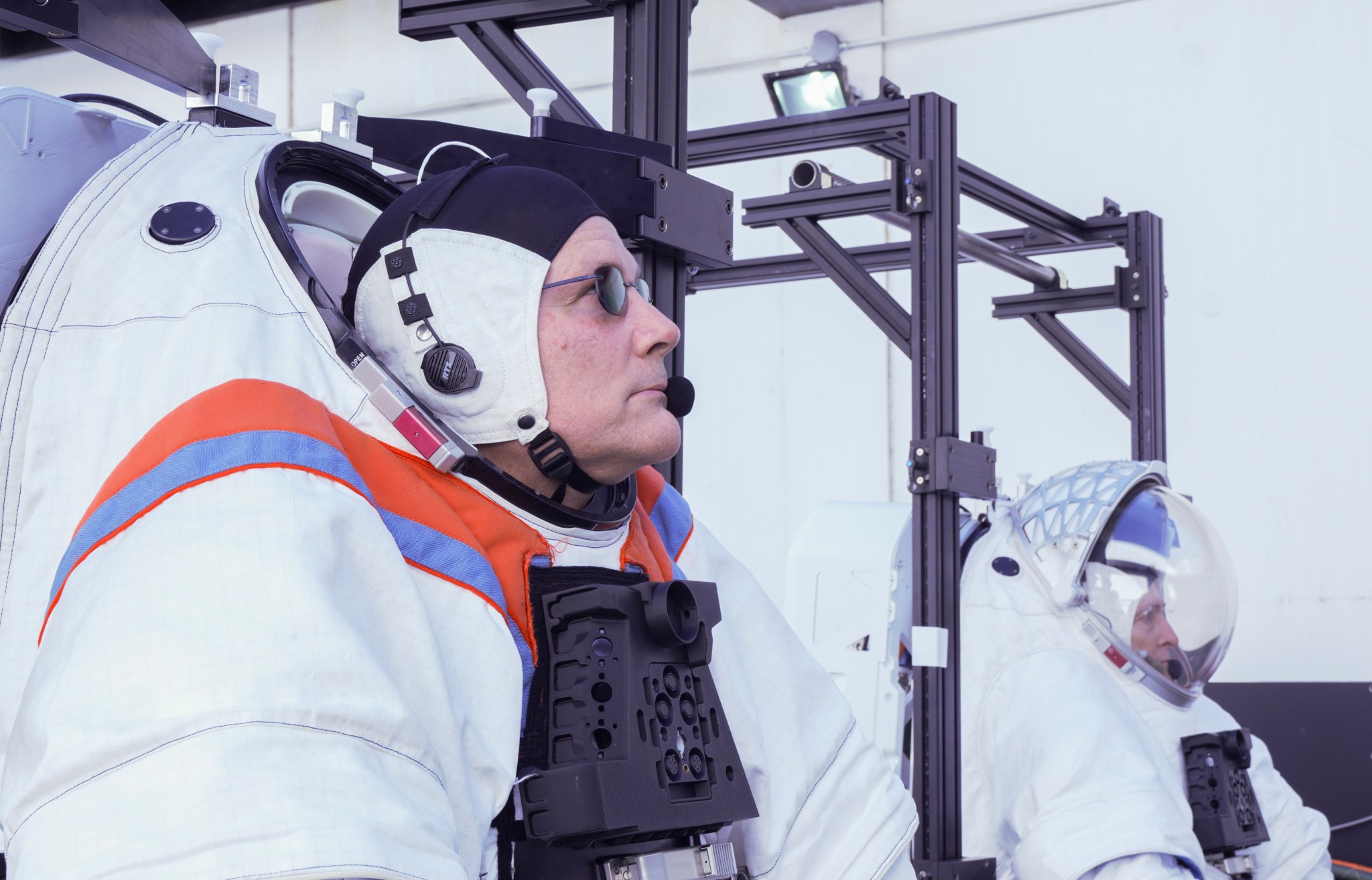
“With Artemis, NASA is going to the Moon in a whole new way, with international partners and industry partners like Axiom Space and SpaceX. These partners are contributing their expertise and providing integral parts of the deep space architecture that they develop with NASA’s insight and oversight,” said Amit Kshatriya, NASA’s Moon to Mars program manager. “Integrated tests like this one, with key programs and partners working together, are crucial to ensure systems operate smoothly and are safe and effective for astronauts before they take the next steps on the Moon.”
The day-long test, conducted at SpaceX headquarters in Hawthorne, California, provided NASA and its partners with valuable feedback on the layout, physical design, mechanical assemblies, and clearances inside the Starship HLS, as well as the flexibility and agility of the suits, known as the AxEMU (Axiom Extravehicular Mobility Unit).
To begin the test, Wheelock and Whitson put on the spacesuits in the full-scale airlock that sits on Starship’s airlock deck. Suits were then pressurized using a system immediately outside the HLS airlock that provided air, electrical power, cooling, and communications to the astronauts. Each AxEMU also included a full-scale model of the Portable Life Support System, or “backpack,” on the back of the suits. For Artemis moonwalks, each crew member will put on a spacesuit with minimal assistance, so the team was eager to evaluate how easily the suits can be put on, taken off, and stowed in the airlock.
During the test, NASA and SpaceX engineers were also able to evaluate placement of mobility aids, such as handrails, for traversing the hatch. Another set of mobility aids, straps hanging from the ceiling in the airlock, assisted the astronauts when entering and removing the AxEMU suits. The astronauts also practiced interacting with a control panel in the airlock, ensuring controls could be reached and activated while the astronauts were wearing gloves.
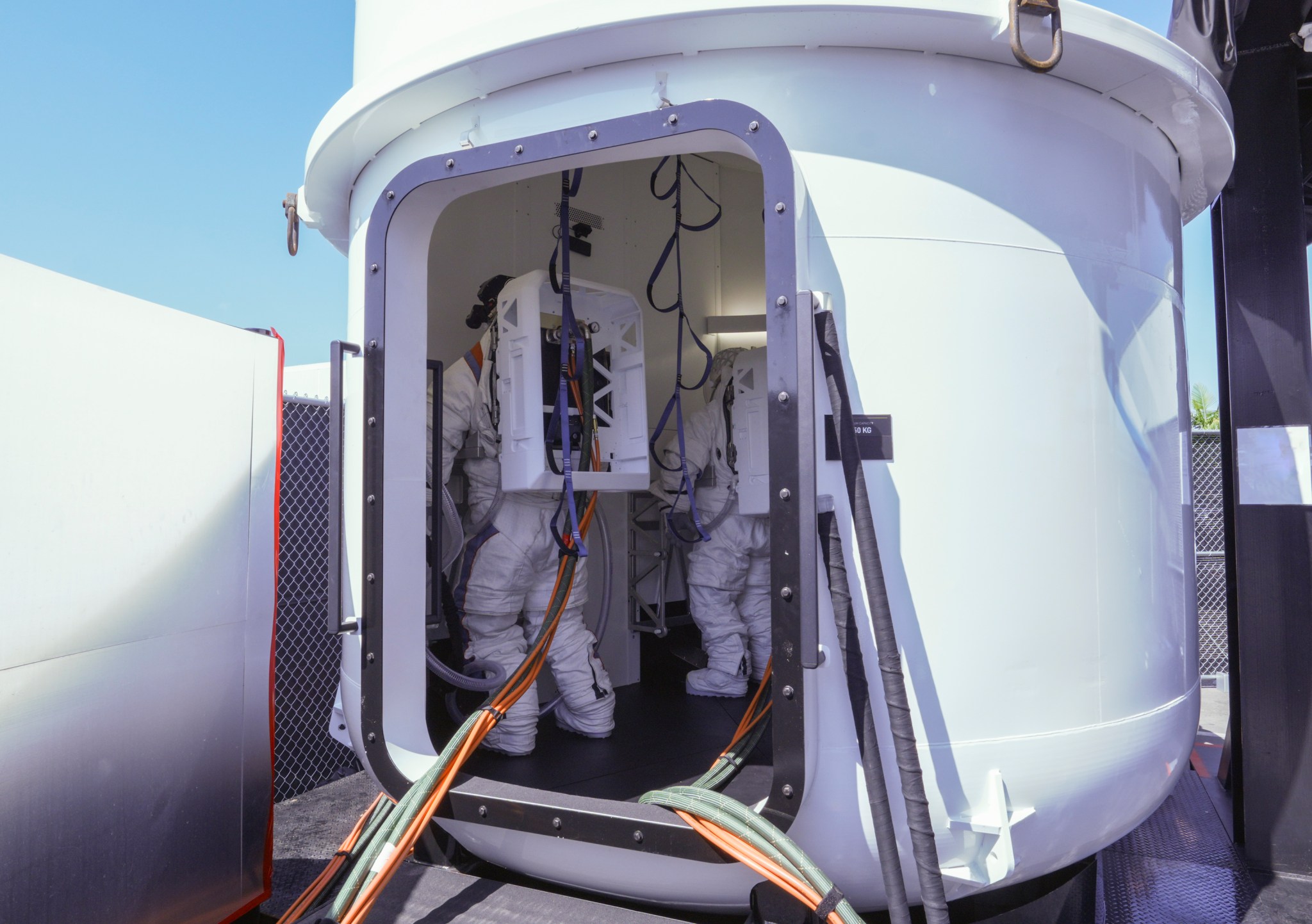
“Overall, I was pleased with the astronauts’ operation of the control panel and with their ability to perform the difficult tasks they will have to do before stepping onto the Moon,” said Logan Kennedy, lead for surface activities in NASA’s HLS Program. “The test also confirmed that the amount of space available in the airlock, on the deck, and in the elevator, are sufficient for the work our astronauts plan to do.”
The suited astronauts also walked the from Starship’s airlock deck to the elevator built for testing. During Artemis missions, the elevator will take NASA astronauts and their equipment from the deck to the lunar surface for a moonwalk and then back again. Whitson and Wheelock practiced opening a gate to enter the elevator while evaluating the dexterity of the AxEMU suit gloves, and practiced lowering the ramp that astronauts will use to take the next steps on the Moon.
The steps the astronauts took in the spacesuits through full-scale builds of the Starship hatch, airlock, airlock deck, and elevator may have been small, but they marked an important step toward preparing for a new generation of moonwalks as part of Artemis.
For the Artemis III mission, SpaceX will provide the Starship HLS that will dock with Orion in lunar orbit and take two astronauts to and from the surface of the Moon. Axiom Space is providing a new generation of spacesuits for moonwalks that are designed to fit a wider range of astronauts.
With Artemis, NASA will explore more of the Moon than ever before, learn how to live and work away from home, and prepare for future human exploration of the Red Planet. NASA’s SLS (Space Launch System) rocket, exploration ground systems, and Orion spacecraft, along with the human landing system, next-generation spacesuits, Gateway lunar space station, and future rovers are NASA’s foundation for deep space exploration.
Learn more about Artemis.

IMAGES
VIDEO
COMMENTS
Voyager 1 discovered a thin ring around Jupiter and two new Jovian moons: Thebe and Metis. At Saturn, Voyager 1 found five new moons and a new ring called the G-ring. Voyager 1 was the first spacecraft to cross the heliosphere, the boundary where the influences from outside our solar system are stronger than those from our Sun. Voyager 1 is the ...
Voyager 1 is a space probe launched by ... and the two spacecraft went on to visit Saturn and its system of moons and rings. Voyager 1 encountered Saturn in November 1980, with the ... On December 3, 2012, Voyager project scientist Ed Stone of the California Institute of Technology said, "Voyager has discovered a new region of the heliosphere ...
Left: Voyager 1 image of Saturn, partially backlit by the Sun. Right: Voyager 1 image of Saturn's largest moon Titan, with evidence of a blue atmospheric haze layer. Voyager 1 began its long-range observations of Saturn on Aug. 22, 1980, passed within 114,500 miles of the planet's center on Nov. 12, and concluded its studies on Dec. 14 ...
On February 17, 1998, Voyager 1 overtook the space probe Pioneer 10 (launched 1972) to become the most distant human-made object in space. By 2004 both Voyagers were well beyond the orbit of Pluto.In 2012 the Voyagers became the longest-operating spacecraft, having functioned for 35 years and still periodically transmitting data. On August 25, 2012, Voyager 1 became the first space probe to ...
One of Voyager 1's targets was the F ring, a thin structure discovered only the year previously by NASA's Pioneer 11 probe. Voyager's higher-resolution camera spotted two new moons, Prometheus and ...
published 5 March 2019. It was 40 years ago today (March 5) that Voyager 1 flew past Jupiter, revealing a surprising planetary system that includes moons of ice and fire. And scientists are still ...
About the mission. Voyager 1 reached interstellar space in August 2012 and is the most distant human-made object in existence. Launched just shortly after its twin spacecraft, Voyager 2, in 1977, Voyager 1 explored the Jovian and Saturnian systems discovering new moons, active volcanoes and a wealth of data about the outer solar system.
First mission to discover multiple moons of the four outer planets (both spacecraft): 3 new moons at Jupiter; 4 new moons at Saturn; 11 new moons at Uranus; ... (at Saturn's moon Titan -- Voyager 1) Heliophysics Firsts. After Voyager 1 departed from Saturn in November 1980, it began a journey to where no human-made object had ever gone before ...
In 2012 Voyager 1 became the first spacecraft to leave the solar system and enter interstellar space—and its sister spacecraft is not far behind. ... The Voyagers discovered many moons around ...
Voyager 2 was launched first, on August 20, 1977; Voyager 1 followed some two weeks later, on September 5. The twin-spacecraft mission took advantage of a rare orbital positioning of Jupiter, Saturn, Uranus, and Neptune that permitted a multiplanet tour with relatively low fuel requirements and flight time. The alignment allowed each spacecraft, following a particular trajectory, to use its ...
As Voyager 1 raced out of the solar system, Voyager 2 struck out on its own toward the last two unvisited giant planets: Uranus and Neptune. Smaller and more distant than Jupiter and Saturn, these ...
And then came the Voyager probes' tour of the solar system. Voyager 2 actually launched first, on August 20, 1977. Voyager 1, the faster craft, left Earth 40 years ago today—September 5, 1977 ...
It did that — and much more. Voyager 1 discovered active volcanoes, moons and planetary rings, proving along the way that Earth and all of humanity could be squished into a single pixel in a ...
Voyager 1 continued toward the far reaches of our cosmic neighborhood, while Voyager 2 would first make historic swoops by Uranus and Neptune - the "ice giants." Again, the moons were stars.
Voyager 1 sent back spectacular photos of Jupiter and its giant red spot. It showed how dynamic the Jovian atmosphere was, with clouds and storms. It also took pictures of Jupiter's moon Io ...
It did that - and much more. Voyager 1 discovered active volcanoes, moons and planetary rings, proving along the way that Earth and all of humanity could be squished into a single pixel in a ...
It was the ultimate remote IT service, spanning 24 billion kilometers of space to fix an antiquated, hobbled computer built in the 1970s. Voyager 1, one of the celebrated twin spacecraft that was the first to reach interstellar space, has finally resumed beaming science data back to Earth after a 6-month communications blackout, NASA announced this week.
Details of how this unusual moon formed remain mysterious. Dinkinesh and its satellite are the first two of 11 asteroids that Lucy's team plans to explore over its 12-year journey. After skimming the inner edge of the main asteroid belt, Lucy is now heading back toward Earth for a gravity assist in December 2024.